





| No. | Domain | Total Question | Correct | Incorrect | Unattempted | Marked for Review |
|---|---|---|---|---|---|---|
| 1 | Develop Azure compute solutions | 14 | 0 | 0 | 14 | 0 |
| 2 | Develop for Azure storage | 7 | 0 | 0 | 7 | 0 |
| 3 | Implement Azure security | 3 | 0 | 0 | 3 | 0 |
| 4 | Monitor, troubleshoot, and optimize Azure solutions | 13 | 0 | 0 | 13 | 0 |
| 5 | Connect to and consume Azure services and third-party services | 18 | 0 | 0 | 18 | 0 |
| Total | All Domains | 55 | 0 | 0 | 55 | 0 |
You have an Azure storage account. You are developing an Application written in C# which has the following snippet
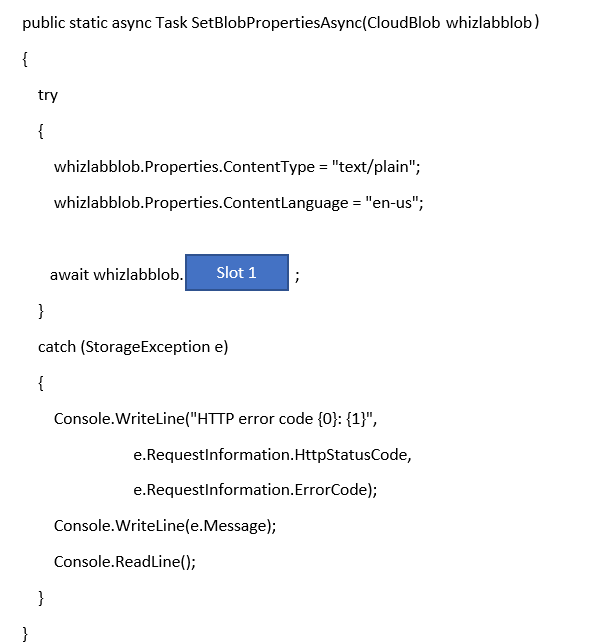
Which of the following should go into Slot 1?
- A. GetPropertiesAsync()
- B. SetPropertiesAsync()
- C. UpdatePropertiesAsync()
- D. NewPropertiesAsync()
Explanation:
Answer – B
An example of this is also given in the Microsoft documentation

Since this is clearly given in the Microsoft documentation, all other options are incorrect
For more information on setting the properties, please refer to the below URL
A company is developing an application for a company. The application is making use of CosmosDB as the backend store. The application store patient details for a hospital.
Below are the key requirements for certain modules
- Requirement 1 - The status for the patient must be the most recent. This should be the case even if multiple users in different locations update the patient's records
- Requirement 2 - The health for a patient is recorded by one module. Here it needs to be ensured that the data must be either the current version or a prior version
- Requirement 3 - When the patient is being discharged, all charges should be processed, and the final bill should be processed
You have to ensure that you minimize the latency and any impact on the availability of the solution
Which of the following consistency level would you choose for Requirement1?
- A. Strong
- B. Bounded Staleness
- C. Consistent Prefix
- D. Eventual
Explanation:
Answer – A
Here since the requirement is that the patient’s record should be the most consistent, there is a need for consistency in data and no staleness. So, we have to choose Strong consistency for this. The Microsoft documentation mentions the following on the consistency level.

The other consistency level options will not give you the required level of consistency
For more information on consistency levels, one can go to the below link
You are developing a new web application in your company which requires retrieving information from Microsoft Graph. Which following query parameter combinations would return only the display name with the last name ‘Bob’?
- A. ?$filter=surname eq 'Bob'&$select=displayName
- B. ?$filter=equals(surname,'Bob')&$select=displayName
- C. ?$filter=surname eq 'Bob'&$only=displayName
- D. ?$filter=equals(surname,'Bob')&$only=displayName
Explanation:
Correct Answer: A
- Option A is CORRECT because $filter returns the result with specific condition and $select specific the property retrieving in the response.
- Option B is incorrect because the syntax is incorrect.
- Option C is incorrect because the syntax is incorrect.
- Option D is incorrect because the syntax is incorrect.
A company is developing an application for a company. The application is making use of CosmosDB as the backend store. The application store patient details for a hospital.
Below are the key requirements for certain modules
- Requirement 1 - The status for the patient must be the most recent. This should be the case even if multiple users in different locations update the patient's records
- Requirement 2 - The health for a patient is recorded by one module. Here it needs to be ensured that the data must be either the current version or a prior version
- Requirement 3 - When the patient is being discharged, all charges should be processed, and the final bill should be processed
You have to ensure that you minimize the latency and any impact on the availability of the solution
Which of the following consistency level would you choose for Requirement3?
- A. Strong
- B. Bounded Staleness
- C. Consistent Prefix
- D. Eventual
Explanation:
Answer – D
As we need to wait for the final charges, we can just wait for all changes to take effect Hence the best consistency level would be "Eventual".
The Microsoft documentation mentions the following on the consistency level.

Since this is the best consistency preference as per the requirement, all the options are invalid.
For more information on consistency levels, one can go to the below link
A development team is developing an application. The application will be storing its data in Azure Cosmos DB – Table API. Below are the fields that are going to be stored in the table.
- Region
- Email address
- Phone number
Below are some key aspects with respect to the fields
- The region field will be used to load balance the data
- There is a chance that some entities may have a blank "Email address".
The following snippet of code needs to be completed that would be used to retrieve a particular data entity from the table
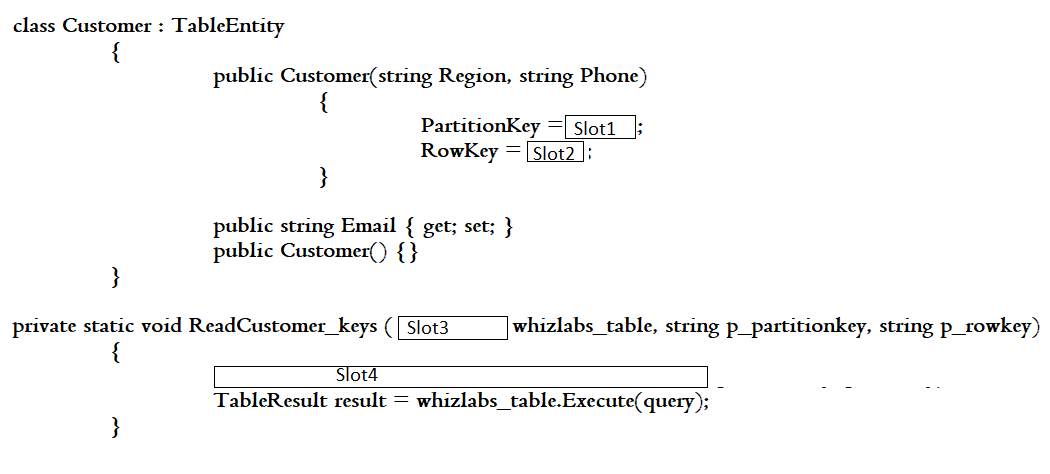
- A. Region
- B. Phone
- C. Email
- D. Key
Explanation:
Answer – A
Since the question states that we will be using Region to load balance the data, we have to use that as the partition key. The Microsoft documentation mentions the following on the partition key design
Complete code is as follows
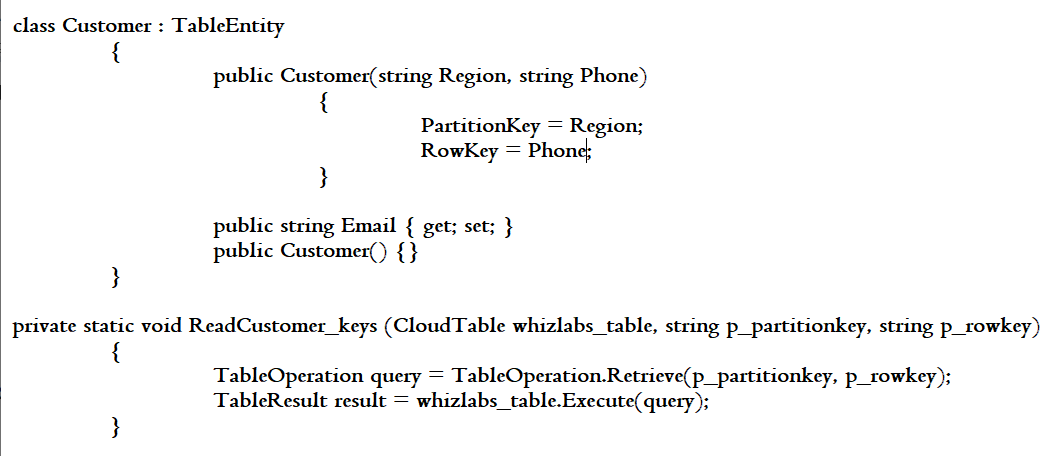

For more information on Azure Table storage design, one can go to the below link
A development team is developing an application. The application will be storing its data in Azure Cosmos DB – Table API. Below are the fields that are going to be stored in the table.
- Region
- Email address
- Phone number
Below are some key aspects with respect to the fields
- The region field will be used to load balance the data
- There is a chance that some entities may have blank email.
The following snippet of code needs to be completed that would be used to retrieve a particular data entity from the table
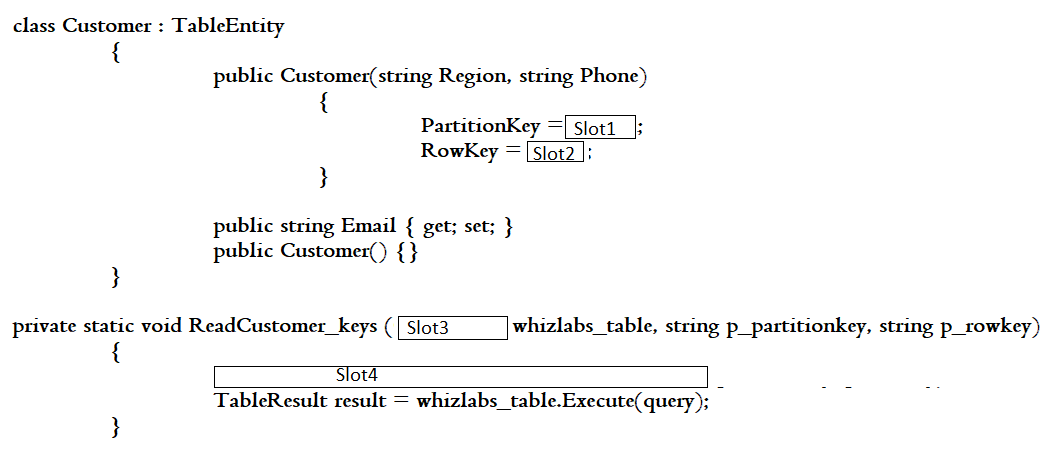
Which of the following will go into Slot2?
- A. Region
- B. Phone
- C. Email
- D. Key
Explanation:
Answer – B
You need to have a value for the RowKey. So, if the email field has missing values for some of the entities, then we have to choose Phone as the RowKey. The Microsoft documentation mentions the following on the Row Key


For more information on understanding the table service data model, one can go to the below link
A development team is developing an application. The application will be storing its data in Azure Cosmos DB – Table API. Below are the fields that are going to be stored in the table.
- Region
- Email address
- Phone number
Below are some key aspects with respect to the fields
- The region field will be used to load balance the data
- There is a chance that some entities may have a blank email address.
The following snippet of code needs to be completed that would be used to retrieve a particular data entity from the table

Which of the following will go into Slot3?
- A. CloudTable
- B. CloudTableClient
- C. TableEntity
- D. TableEntityAdapter
Explanation:
Answer – A
Since we are passing in a table parameter, and this would be a reference to our cloud table, we would need to use the CloudTable data type.
An example snippet of code is given below

Since this is clearly given in the Microsoft documentation, all other options are incorrect
For more information on using table storage with .Net, one can go to the below link
A development team is developing an application. The application will be storing its data in Azure Cosmos DB – Table API. Below are the fields that are going to be stored in the table.
- Region
- Email address
- Phone number
Below are some key aspects with respect to the fields
- The region field will be used to load balance the data
- There is a chance that some entities may have blank email.
The following snippet of code needs to be completed that would be used to retrieve a particular data entity from the table

Which of the following will go into Slot4?
- A. TableEntity query=TableEntity.Retrieve(p_partitionkey,p_rowkey)
- B. TableOperation query=TableOperation.Retrieve(p_partitionkey,p_rowkey)
- C. TableResult query=TableQuery.Retrieve(p_partitionkey,p_rowkey)
- D. TableResultSegment query=TableResult.Retrieve(p_partitionkey,p_rowkey)
Explanation:
Answer – B
If we need to retrieve an entity based on the partition and row key , we will need to use the TableOperation method.
Snippet is as below

An example snippet of code in the Microsoft documentation is given below
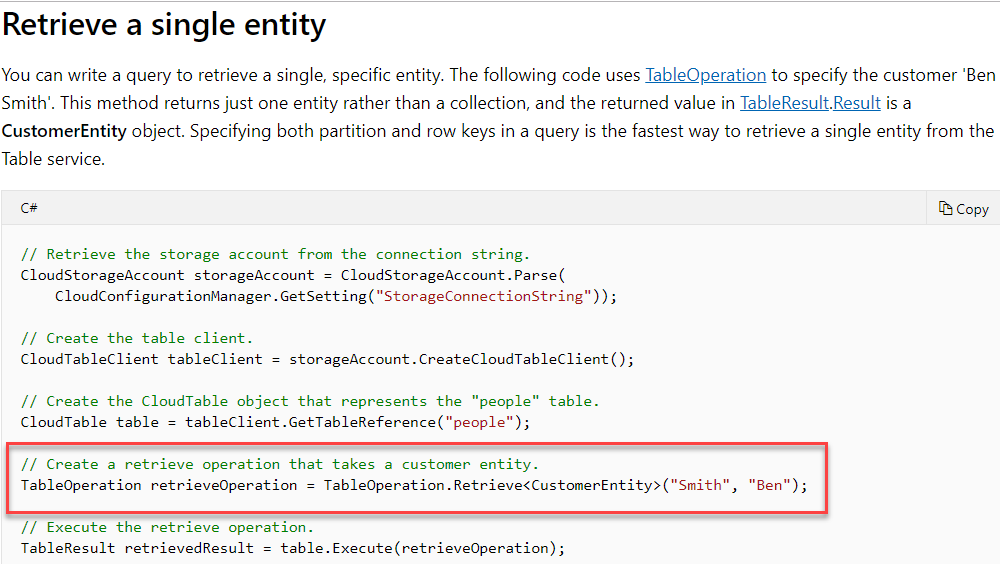
Since this is clearly given in the Microsoft documentation, all other options are incorrect
For more information on using table storage with .Net, one can go to the below link
A company has a web application that has been deployed using the Azure Web App service. The current service plan being used is D1. It needs to be ensured that the application infrastructure can automatically scale when the CPU load reaches 85 percent. You also have to ensure costs are minimized. Which of the following steps would you implement to achieve the requirements? Choose 4 answers from the options given below
- A. Enable autoscaling on the Web application
- B. Configure a scale condition
- C. Configure the web application to use the Standard App Service Plan
- D. Configure the web application to use the Premium App Service Plan
- E. Add a scale rule.
Explanation:
Answer – A, B, C and E
Since the app service plan being used is D1, that means this is the Shared Service Plan as shown below. And this plan does not have support for Autoscaling
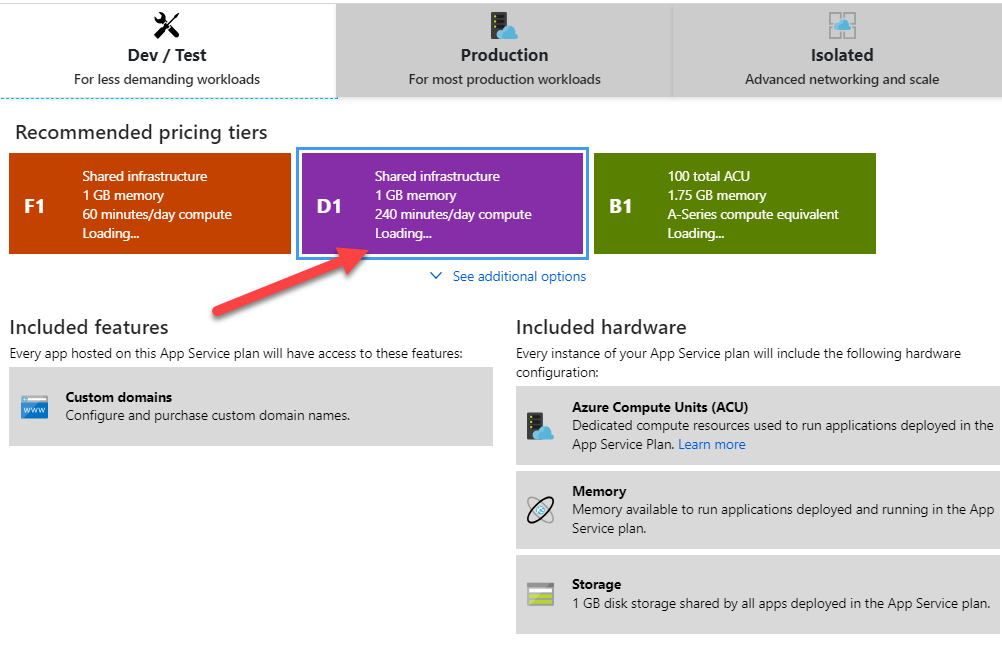
Step 1) We have to scale up to at least the Standard App service plan.
Once this is done, you can now see the ability to enable Autoscale when you go to the Scale out section for the Azure Web App
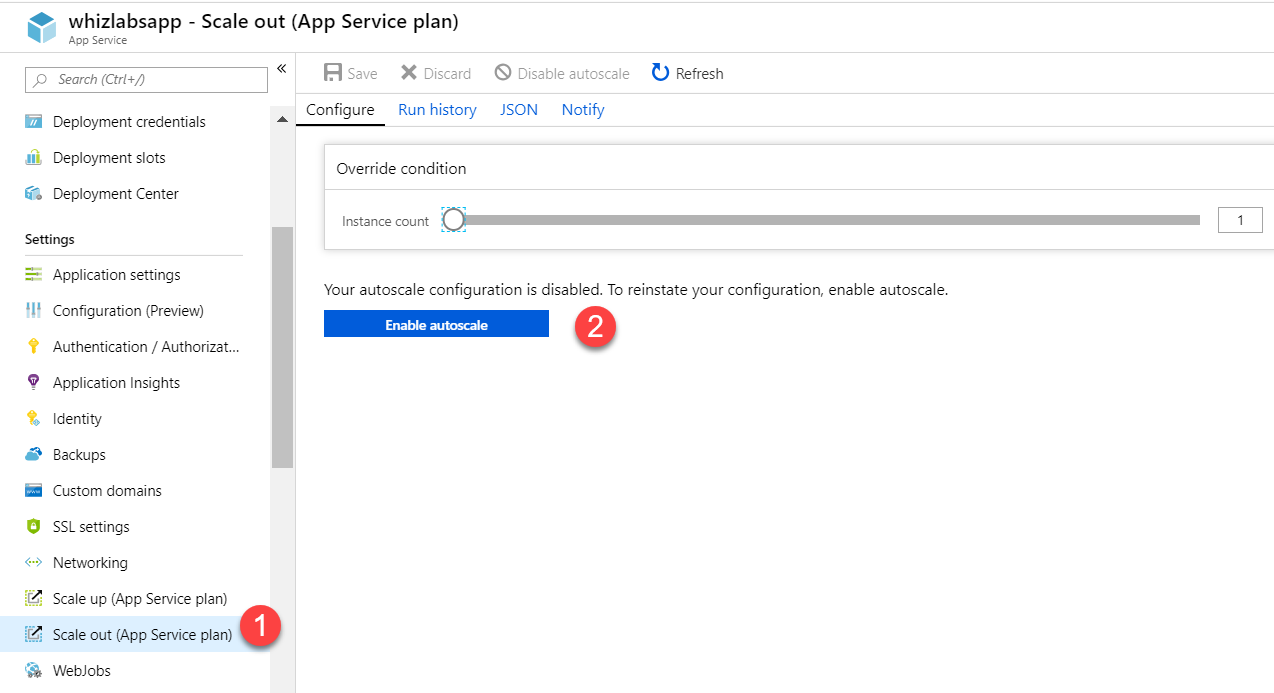
Step 2) Next you add a scale condition and a rule for autoscaling based on a CPU threshold.
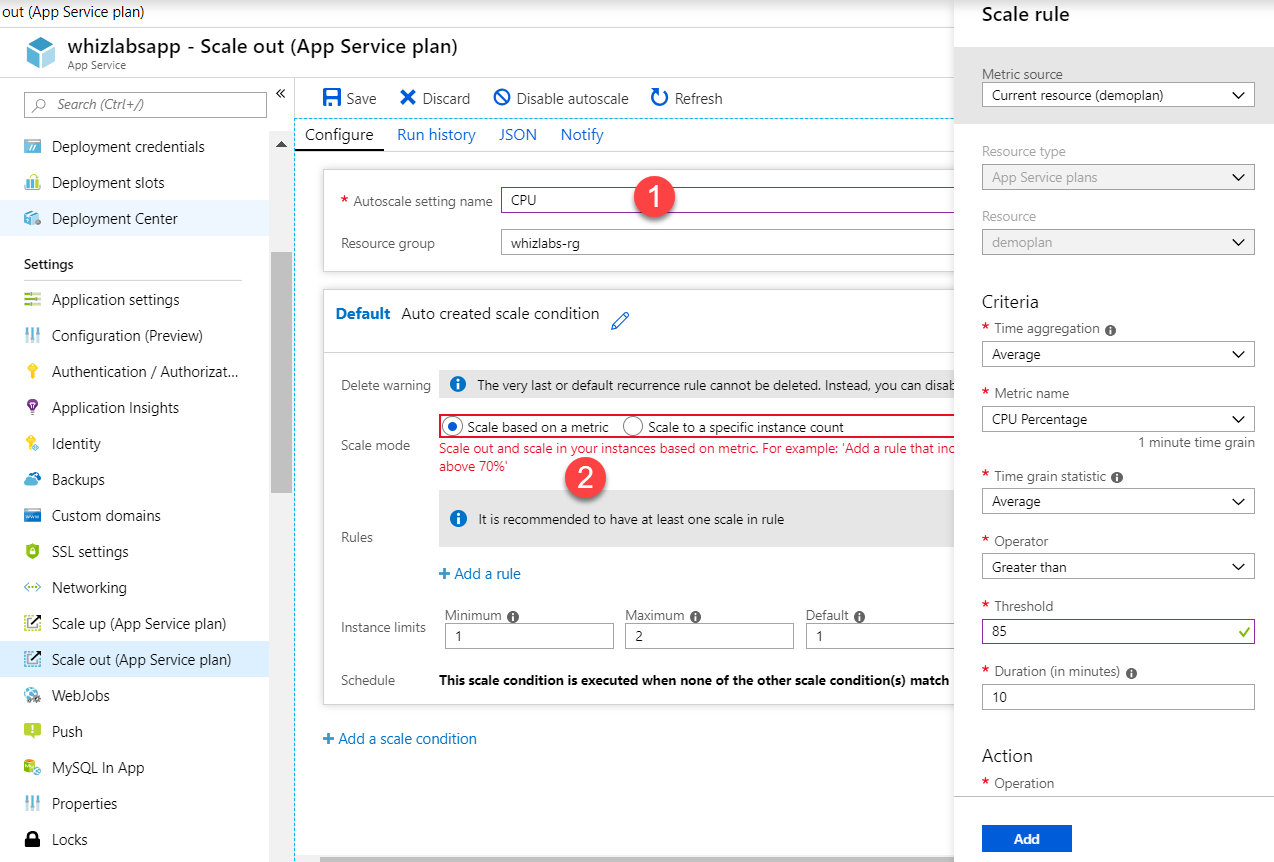
Option D is incorrect since the Premium app service plan would be a more expensive option.
For more information on Azure Web App Autoscaling, one can go to the below link
A company is planning on using the Azure CDN service to distribute static images.
Below is a set of steps in a random order which would be followed by the CDN service.
Drag the correct options from the Actions area and drop them to the answer area for
Implementing the correct process of how the Content Delivery service would distribute the images.
- Correct Answer
- 1.
A user requests an image from the CDN URL. The DNS routes the request to the best performing Point of Presence location
- 2.
If no edge server in the Point of Presence has an image in the cache, the Point of Presence will request the image from the origin server
- 3.
The Origin server will return an image to the Edge server in the Point of Presence. The edge server will cache the image and return the image to the user
- 4.
Subsequent requests for the image may be directed to the same Point of Presence. The Point of Presence will return the image if the TTL has not expired
Explanation:
Correct Answers:
|
1 |
A user requests an image from the CDN URL. The DNS routes the request to the best performing Point of Presence location |
|
2 |
If no edge server in the Point of Presence has an image in the cache, the Point of Presence will request the image from the origin server. |
|
3 |
The Origin server will return an image to the Edge server in the Point of Presence. The edge server will cache the image and return the image to the user |
|
4 |
Subsequent requests for the image may be directed to the same Point of Presence. The Point of Presence will return the image if the TTL has not expired. |
- A user (Alice) requests a file (also called an asset) by using a URL with a special domain name, such as .azureedge.net. This name can be an endpoint hostname or a custom domain. The DNS routes the request to the best performing POP location, which is usually the POP that is geographically closest to the user.
- If no edge servers in the POP have the file in their cache, the POP requests the file from the origin server. The origin server can be an Azure Web App, Azure Cloud Service, Azure Storage account, or any publicly accessible web server.
- The origin server returns the file to an edge server in the POP.
- An edge server in the POP caches the file and returns the file to the original requestor (Alice). The file remains cached on the edge server in the POP until the time-to-live (TTL) specified by its HTTP headers expires. If the origin server didn't specify a TTL, the default TTL is seven days.
- Additional users can then request the same file by using the same URL that Alice used and can also be directed to the same POP.
- If the TTL for the file hasn't expired, the POP edge server returns the file directly from the cache. This process results in a faster, more responsive user experience.
How Azure Content Delivery Network (CDN) works
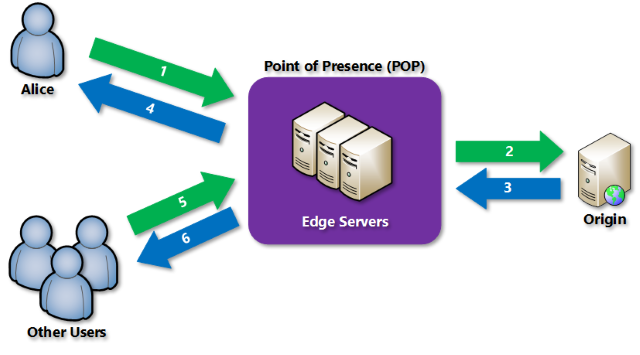
Reference:
For more information about the Azure CDN please refer to the link below
A company needs to develop a script that will do the following
- Create an Azure Web App
- Create the Web App service plan
- Ensure automatic deployment of code from Github
The following variables are in place
|
Variable Name |
Variable value |
|
$gitrepo |
https://github.com/whizlabs/app |
|
$webappname |
whizlabsapp |
You have to complete the following script
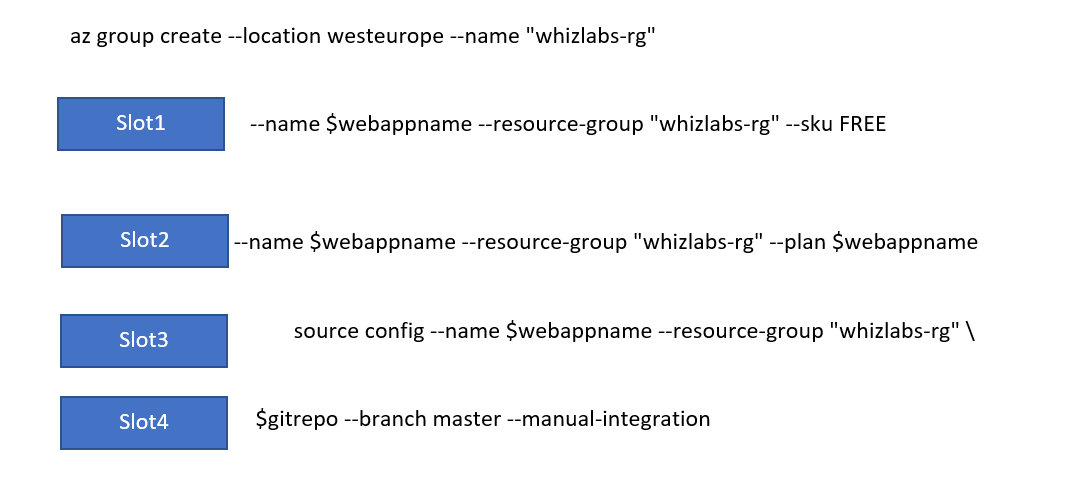
Which of the following would go into Slot1?
- A. az webapp create
- B. az appservice plan create
- C. az webapp deployment
- D. az group assign
Explanation:
Answer – B
This is given as an example in the Microsoft documentation
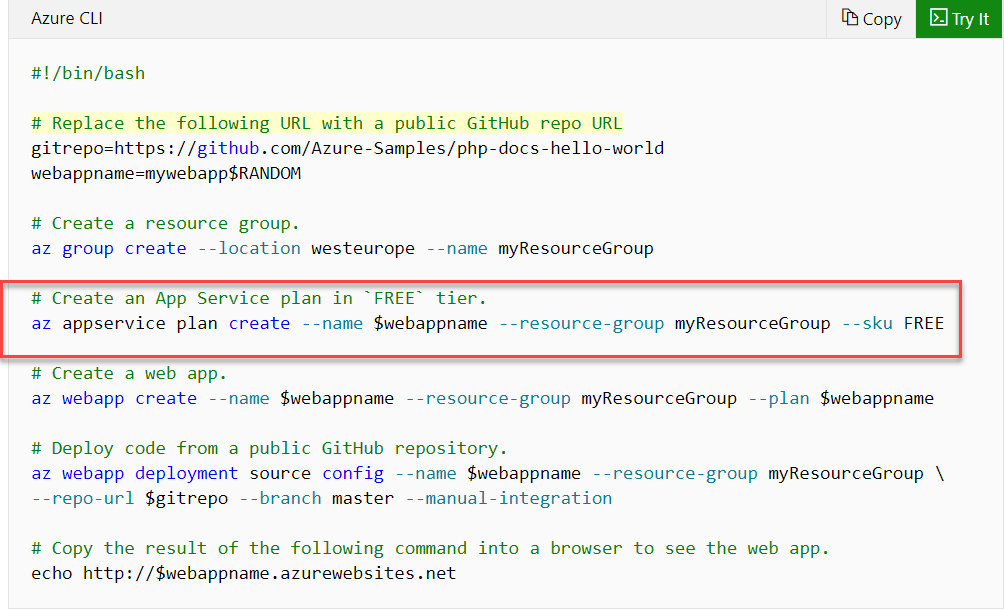
Since this is clearly given in the documentation, all other options are incorrect
For more information on using the CLI for deployment, one can go to the below link
A company needs to develop a script that will do the following
- Create an Azure Web App
- Create the Web App service plan
- Ensure automatic deployment of code from Github
The following variables are in place
|
Variable Name |
Variable value |
|
$gitrepo |
https://github.com/whizlabs/app |
|
$webappname |
whizlabsapp |
You have to complete the following script
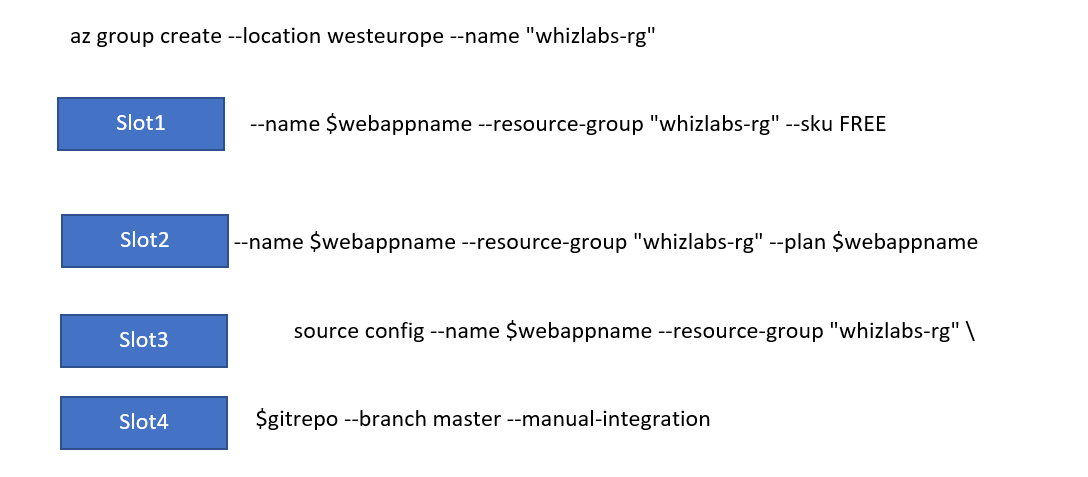
Which of the following would go into Slot2?
- A. az webapp create
- B. az appservice plan create
- C. az webapp deployment
- D. az group assign
Explanation:
Answer – A
Since this is clearly given in the documentation, all other options are incorrect
For more information on using the CLI for deployment, one can go to the below link
This is given as an example in the Microsoft documentation
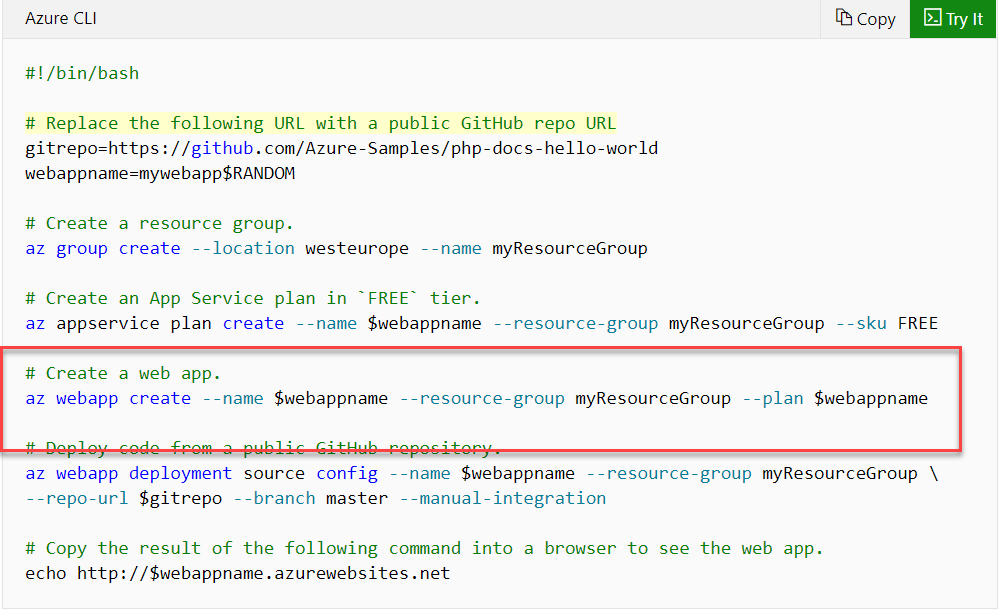
Since this is clearly given in the documentation, all other options are incorrect
For more information on using the CLI for deployment, one can go to the below link
A company needs to develop a script that will do the following
- Create an Azure Web App
- Create the Web App service plan
- Ensure automatic deployment of code from Github
The following variables are in place
|
Variable Name |
Variable value |
|
$gitrepo |
https://github.com/whizlabs/app |
|
$webappname |
whizlabsapp |
You have to complete the following script
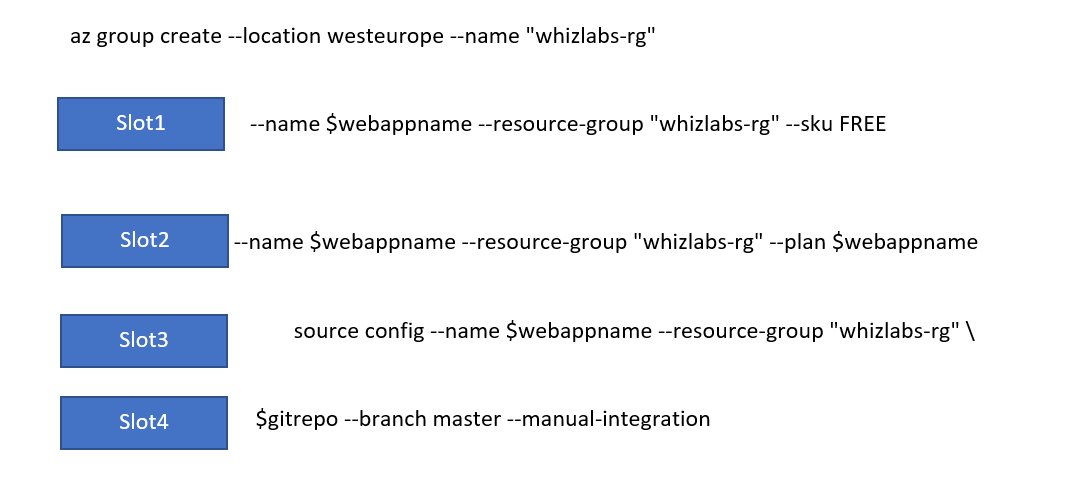
Which of the following would go into Slot3?
- A. az webapp create
- B. az appservice plan create
- C. az webapp deployment
- D. az group assign
Explanation:
Answer – C
Since this is clearly given in the documentation, all other options are incorrect
This is given as an example in the Microsoft documentation
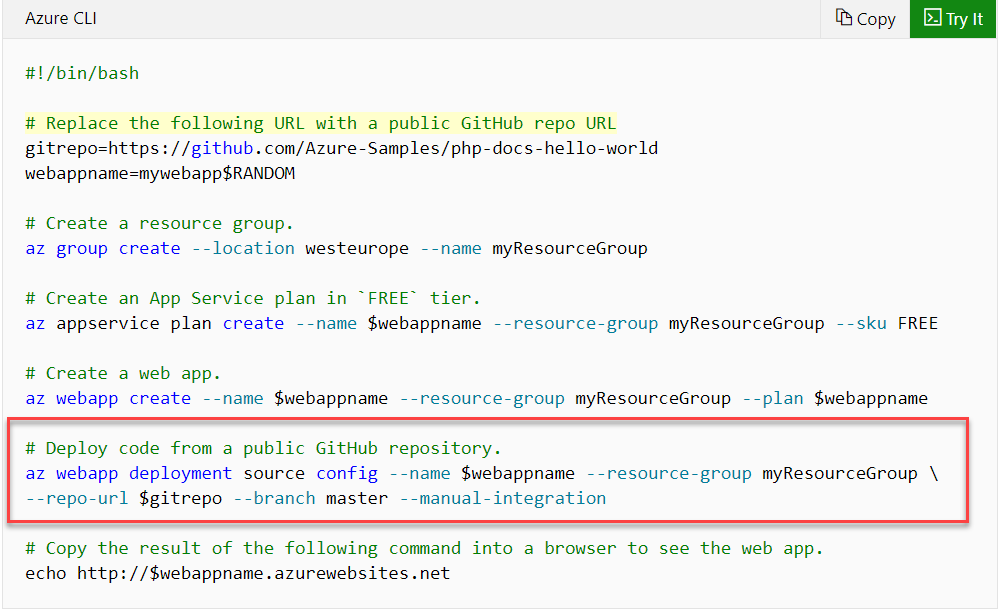
Since this is clearly given in the documentation, all other options are incorrect
For more information on using the CLI for deployment, one can go to the below link
A company needs to develop a script that will do the following
- Create an Azure Web App
- Create the Web App service plan
- Ensure automatic deployment of code from Github
The following variables are in place
|
Variable Name |
Variable value |
|
$gitrepo |
https://github.com/whizlabs/app |
|
$webappname |
whizlabsapp |
You have to complete the following script
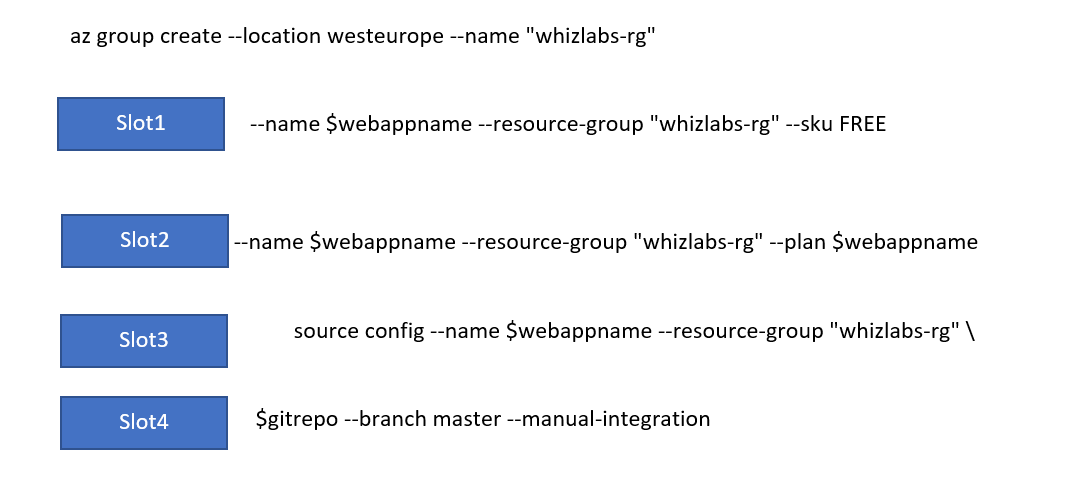
Which of the following would go into Slot4?
- A. --repo-url
- B. --github-deploy
- C. --github-repo
- D. --repo-deploy
Explanation:
Answer – A
This is given as an example in the Microsoft documentation
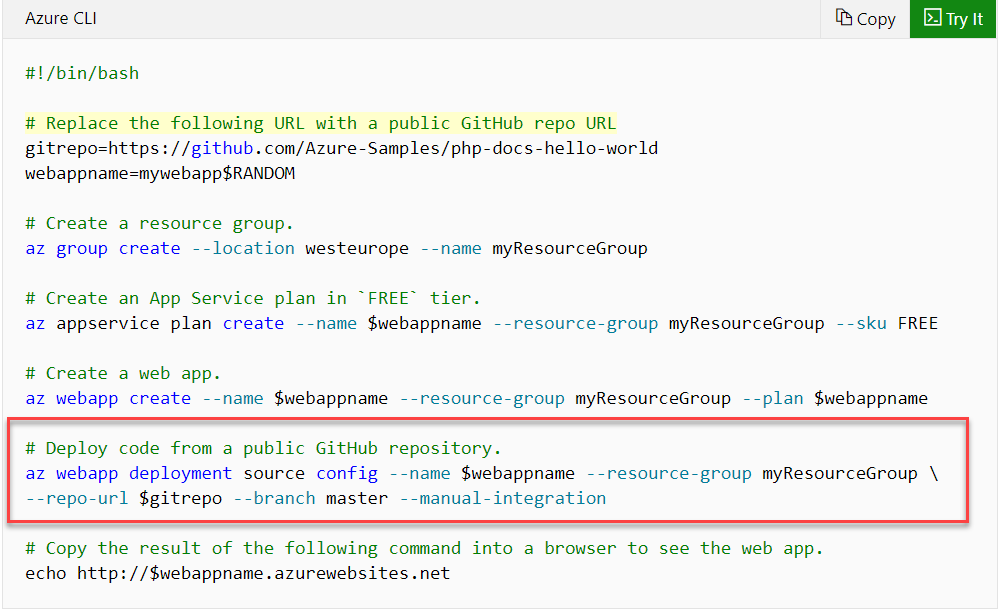
Since this is clearly given in the documentation, all other options are incorrect
For more information on using the CLI for deployment, one can go to the below link
A company is developing a web site. They are planning on deploying the web site to Azure. There is a requirement to ensure that the web site remains available when it experiences high volumes of traffic. You need to minimize on cost. Which of the following would you consider from a deployment perspective?
- A. Deploy the website to an App Service that uses the Shared service tier. Configure the App Service plan to automatically scale when the CPU load is high.
- B. Deploy the website to a virtual machine. Configure the virtual machine to automatically scale when the CPU load is high.
- C. Deploy the website to an App Service that uses the Standard service tier. Configure the App Service plan to automatically scale when the CPU load is high.
- D. Deploy the website to a virtual machine. Configure a Scale Set to increase the virtual machine instance count when the CPU load
Explanation:
Answer – C
Web Apps deployed to the Standard App Service Plan have the ability to scale up based on demand.
Below is the sample implementation snapshots.
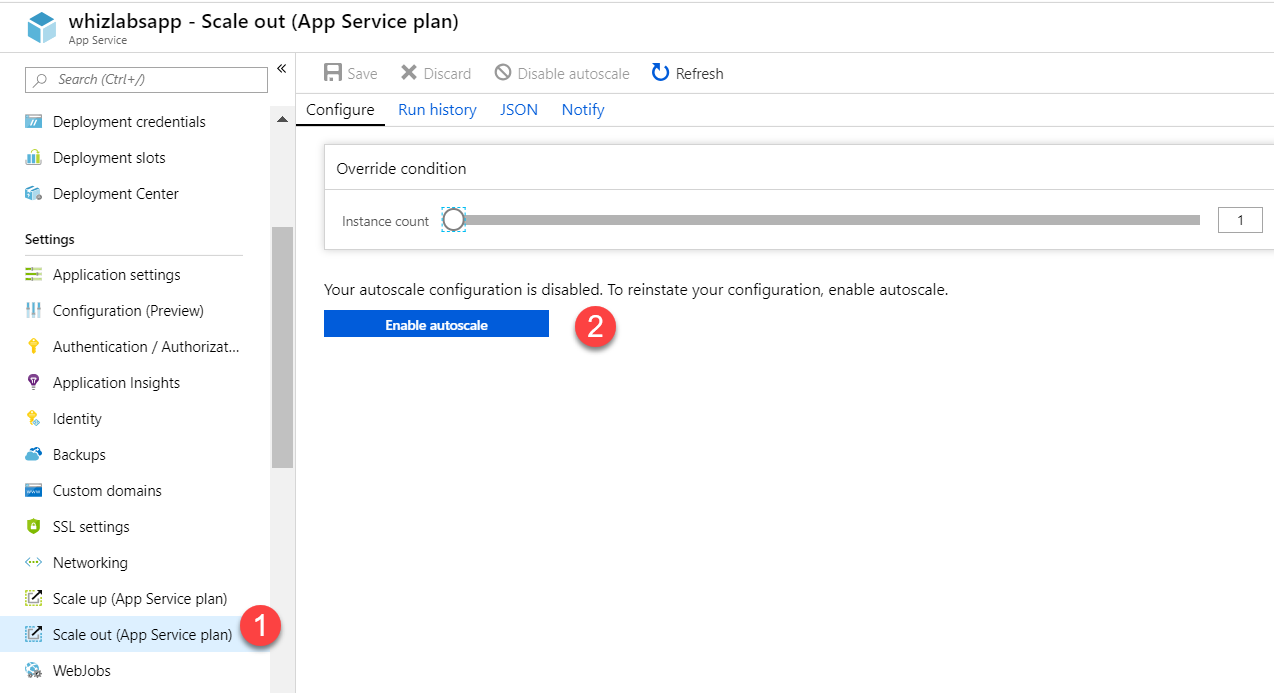
You can add a scale condition and a rule for autoscaling based on a CPU threshold.
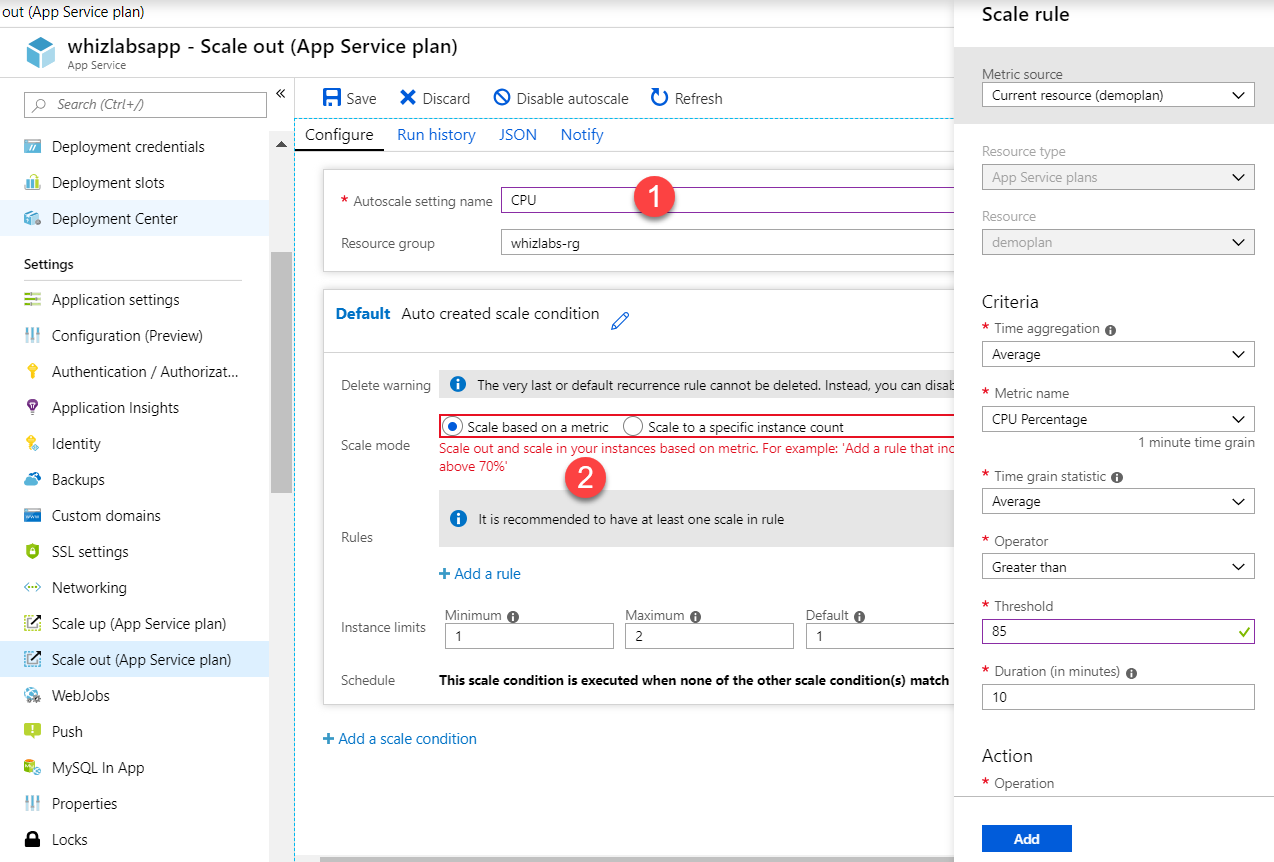
Option A is incorrect since the Shared App Service plan does not have the option to scale the application based on demand.
Option B is incorrect since you need to scale amongst multiple instances
Option D is incorrect since this would not be cost effective
For more information on Azure Web App Autoscaling, one can go to the below link
Your team has developed an application API based on the OpenAPI specification. You have to ensure that the API can be accessed via an Azure API management service instance. Which of the following Azure powershell command would you run?
- A. Import-AzApiManagementApi -Context $whizlabsApiMgmtContext -SpecificationFormat "Swagger" -SpecificationPath $whizlabsSwaggerPath -Path $whizlabsPath
- B. New-AzApiManagementBackend -Context $whizlabsApiMgmtContext -Url $whizlabsurl -Protocol http
- C. New-AzApiManagement -ResourceGroupName $whizlabs-rg -Name $whizlabsname -Location $Location -Organization "Whizlabs" -AdminEmail $whizlabsadmin
- D. New-AzApiManagementBackendProxy -Url $whizlabsurl
Explanation:
Answer – C
First you need to create a new API management instance as shown below

Option A is incorrect
Import-AzApiManagementApi is for import and not to create a new
Option B is incorrect since this is used to create a new backend for the API
Option D is incorrect since this is used is just used to create a new backend proxy
For more information on creating an API Instance, one can go to the below link
Your team has to develop an application that will be used to capture events from multiple IoT enabled devices. Your team is planning on using Azure Event Hubs for the ingestion of the events. As part of the requirement, you have to ensure that the events are persisted to Azure Blob Storage.
Which of the following Azure Event Hub feature would you use to persist the data onto Azure Blob Storage?
- A. Throughput Units
- B. Partition Keys
- C. Event Hubs Capture
- D. Event Streams
Explanation:
Answer – C
Data can be persisted from Azure Event Hubs Capture onto Azure Blob storage with the help of Azure Event Hubs Capture.
The Microsoft documentation mentions the following
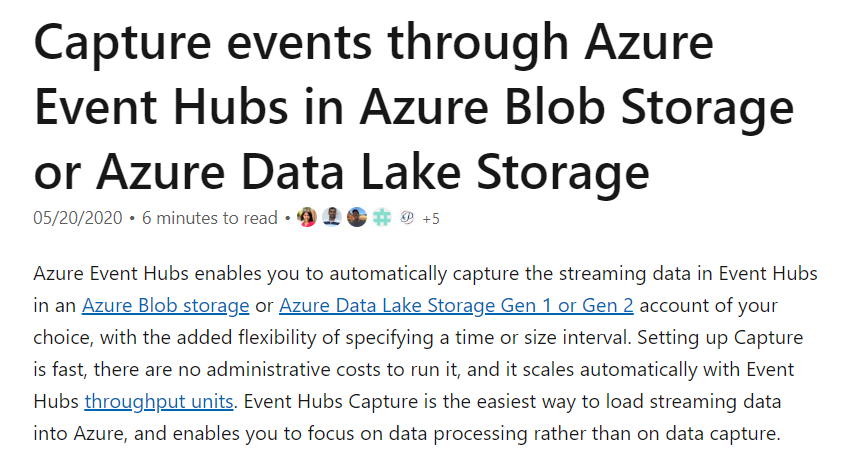
Since this is clearly mentioned in the Microsoft documentation, all other options are incorrect
For more information on Azure Event Hubs capture, please refer to the below link
Your team has to develop an application that will be used to capture events from multiple IoT enabled devices. Your team is planning on using Azure Event Hubs for the ingestion of the events. As part of the requirement, you have to ensure that the events are persisted to Azure Blob Storage.
When data is persisted from Azure Event Hubs onto Azure Blob Storage, which of the following is the data format used to write the data?
- A. JSON
- B. Apache Avro
- C. XML
- D. TXT
Explanation:
Answer – B
The data is written in Apache Avro format
The Microsoft documentation mentions the following
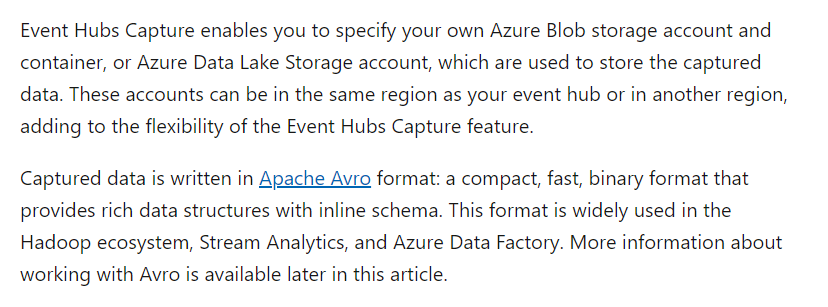
Since this is clearly mentioned in the Microsoft documentation, all other options are incorrect
For more information on Azure Event Hubs capture, please refer to the below link
You have to develop a web application that will use Azure Cache for Redis. You have to ensure that stale keys are removed from the cache using the right techniques. Which of the following can be used for this purpose? Choose 2 answers from the options given below
- A. Choose an eviction policy
- B. Set the right partition key
- C. Set a key expiration value
- D. Choose the right pricing tier
Explanation:
Answer – A and C
For ensuring stale data is removed from the cache, you can either use an eviction policy or set a key expiration value.
The Microsoft documentation mentions the following
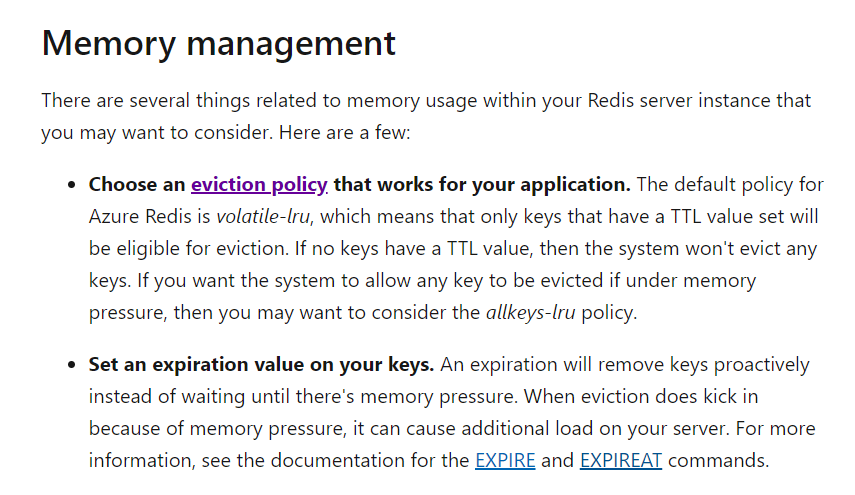
Since this is clearly mentioned in the Microsoft documentation, all other options are incorrect
For more information on Azure Cache for Redis best practices, please refer to the below link
You have to ensure that all sign-in and sign-out events can be processed by the EventGridController.
You propose the following solution
“Create separate Azure Event Grid topics and subscriptions for sign-in and sign-out events.”
Does this solution meet the requirement?
- A. Yes
- B. No
Explanation:
Answer - A
Yes, you can create topics for both the sign in and sign out events.
For more information on posting to a custom topic, one can go to the below link
You have to ensure that all sign-in and sign-out events can be processed by the EventGridController.
You propose the following solution
“Create a new Azure Event Grid subscription for all authentication that delivers messages to an Azure Event Hub. Use the subscription to process sign-out events”
Does this solution meet the requirement?
- A. Yes
- B. No
Explanation:
Answer – B
The Azure Event Hub is normally used as a data ingestion service
For more information on Event Hubs, one can go to the below link
You have to ensure that all sign-in and sign-out events can be processed by the EventGridController.
You propose the following solution
“Create a new Azure Event Grid topic and add a subscription for the events.”
Is this the best way to do this?
- A. Yes
- B. No
Explanation:
Answer – B
It is better to create separate topics. Since the sign-outs need to be processed immediately, you should create a separate topic for the sign in a separate topic for the sign-out process.
For more information on posting to a custom topic, one can go to the below link
Whizlabs is planning to implement Application Insights instrumentation capabilities utilizing the Azure Mobile Apps SDK to provide meaningful analysis of user interactions with a mobile app.
You as an Azure Developer need to capture the data required to implement the Usage Analytics feature of Application Insights.
Which data values should you not capture?
- A. Exception
- B. Events
- C. Session Id
- D. Trace
Explanation:
Answer – C
Application Insights is a monitoring tool from Azure and used to monitor resources deployed in Azure or outside.
This tool sends telemetry of various kinds of data to the Application Insights service where your data can be visualized in the Azure Portal.
And as a developer, you need to capture Trace, Exception, and Events but not Session Id.
Session Id is managed by ARM.
user id & Event id is managed by the browser on the client-side.
Application Insights manages the ID of a session for you. If you want to override the generated ID with your own, it can be done like this:
Since the question is asking for "Which data values should not you capture?"
The answer should be Option C: Session Id
Three of the usage blades use the same tool to slice and dice telemetry from your web app from three perspectives. By filtering and splitting the data, you can uncover insights about the relative usage of different pages and features.
-
Users tool: How many people used your app and its features. Users are counted by using anonymous IDs stored in browser cookies. A single person using different browsers or machines will be counted as more than one user.
-
Sessions tool: How many sessions of user activity have included certain pages and features of your app. A session is counted after half an hour of user inactivity, or after 24 hours of continuous use.
-
Events tool: How often certain pages and features of your app are used. A page view is counted when a browser loads a page from your app, provided you have instrumented it.
A custom event represents one occurrence of something happening in your app, often a user interaction like a button click or the completion of some task. You insert code in your app to generate custom events.
You have to use Azure Table storage to store customer information for an application.
The data contains customer details and is partitioned by the last name.
You need to create a query that returns all customers with the last name Smith. Which code segment should you use in Java?
- A. TableQuery.GenerateFilterCondition("LastName", QueryComparisons.Equal, "Smith") ;
- B. TableQuery.GenerateFilterCondition("PartitionKey", QueryComparisons.Equal, "Smith") ;
- C. TableQuery.GenerateFilterCondition("LastName", Equals, "Smith") ;
- D. TableQuery.GenerateFilterCondition("PartitionKey", Equals, "Smith") ;
Explanation:
Answer – B
To retrieve all entries from an Azure Table storage table created with PartitionaKey with the last name "Smith"
We need to create the query operation for all customer entities
where PartitionKey="Smith".
TableQuery query = new TableQuery().Where(TableQuery.GenerateFilterCondition("PartitionKey",QueryComparisons.Equal, "Smith"));
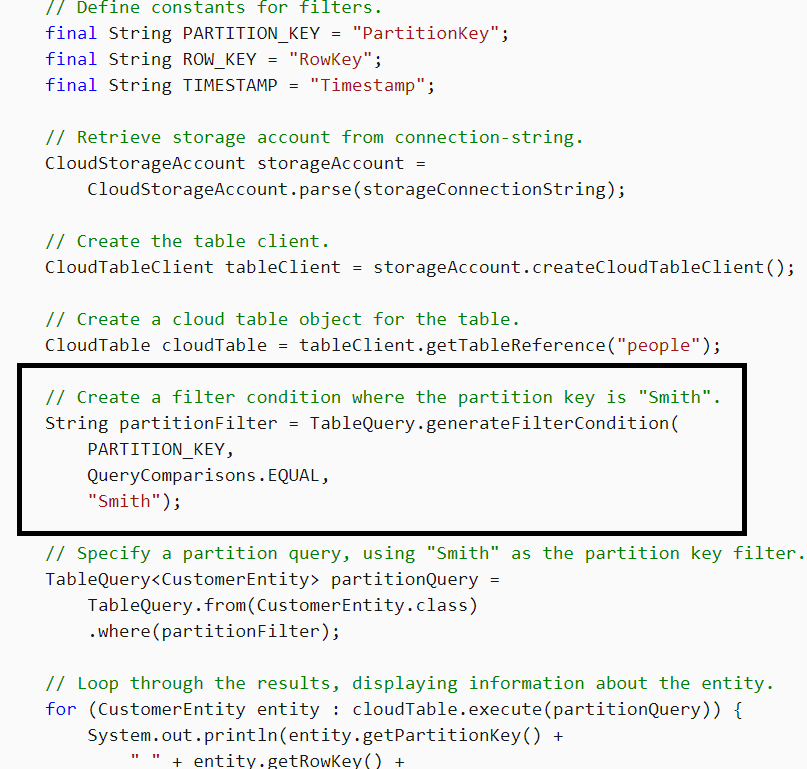
The reference Example is at
https://docs.microsoft.com/en-us/azure/cosmos-db/table-storage-how-to-use-java
Whizlabs data science group built ContentAnalysisService which accepts user-generated content as a string and returns a probable value for inappropriate content.
- Any values over a specific threshold must be reviewed by an employee of Whizlabs.
- You need to store the user agreements data in the pipeline due for further processing.
- The volume of agreements is expected to be in the millions per hour.
Where should you store the agreement data in the pipeline due for further processing?
- A. Azure Storage queue
- B. Azure Service Bus topic
- C. Azure Event Grid topic
- D. Azure Event Hub
Explanation:
Correct Answer – D
A message is raw data produced by a service to be consumed or stored elsewhere. The message contains the data that triggered the message pipeline. The publisher of the message has an expectation about how the consumer handles the message. A contract exists between the two sides. For example, the publisher sends a message with the raw data and expects the consumer to create a file from that data and send a response when the work is done.
Azure Event Hubs is a big data pipeline. It facilitates the capture, retention, and replay of telemetry and event stream data. The data can come from many concurrent sources. Event Hubs allow telemetry and event data to be made available to a variety of stream-processing infrastructures and analytics services. It is available either as data streams or bundled event batches. This service provides a single solution that enables rapid data retrieval for real-time processing as well as a repeated replay of stored raw data. It can capture the streaming data into a file for processing and analysis.
It has the following characteristics:
- low latency
- capable of receiving and processing millions of events per second
- at least once delivery
Ref: https://docs.microsoft.com/en-us/azure/event-grid/compare-messaging-services#comparison-of-services

The question is for a solution for "which accepts user-generated content as a string and returns a probable value for inappropriate content"
So we have data in streaming.
A: Azure Service Bus topic
B: Azure Storage queue
C: Azure Event Grid topic
All these Options are not data in streaming. Hence these are wrong.
A company has deployed a web app on Azure App Services which sends an email at a particular event.
Users report that anomaly detection emails can sometimes arrive several minutes after an anomaly is detected. How can you resolve this issue?
- A. Ensure that the Azure Function is using an App Service plan.
- B. Set Always On to false
- C. Ensure that the Azure Function is set to use a consumption plan.
- D. Set Always On to true.
Explanation:
Answer – D
Here the issue is that the Azure Web app is being stopped when it is not being used. For this, you have to ensure the AlwaysOn setting for the Web App is implemented as True as shown below
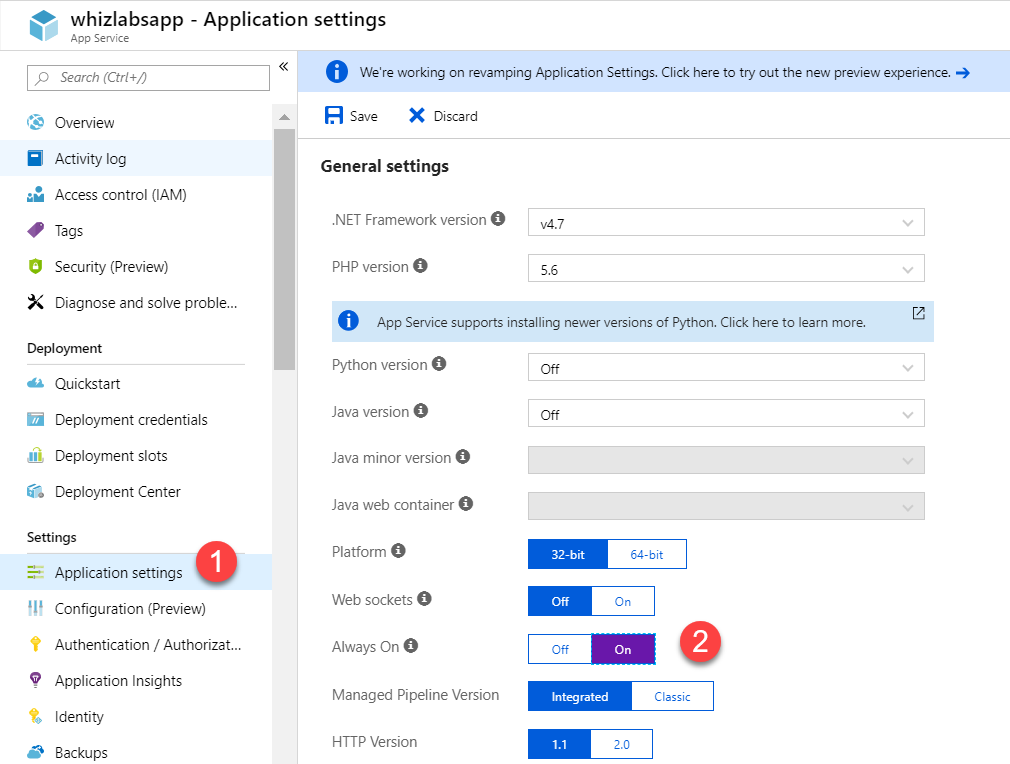
The Microsoft documentation mentions the following on the setting.

Options A and C are incorrect since this is not an issue with the Azure Function, but with the Web App
Option B is incorrect since the setting should be True
For more information on Azure Web App settings, one can go to the below link
The “WhizlabsPolicyService” application must be able to scale on demand. Which Azure Application Insights data model should you use?
- A. An Application Insights metric
- B. An Application Insights dependency
- C. An Application Insights trace
- D. An Application Insights event
Explanation:
Answer – A
Here the question asks us, "Which Azure Application Insights data model should you use to scale web App Services?"
You can use Application Insights metrics to scale Web Apps. The Microsoft documentation gives an example of this where the source of the metric is Application Insights.
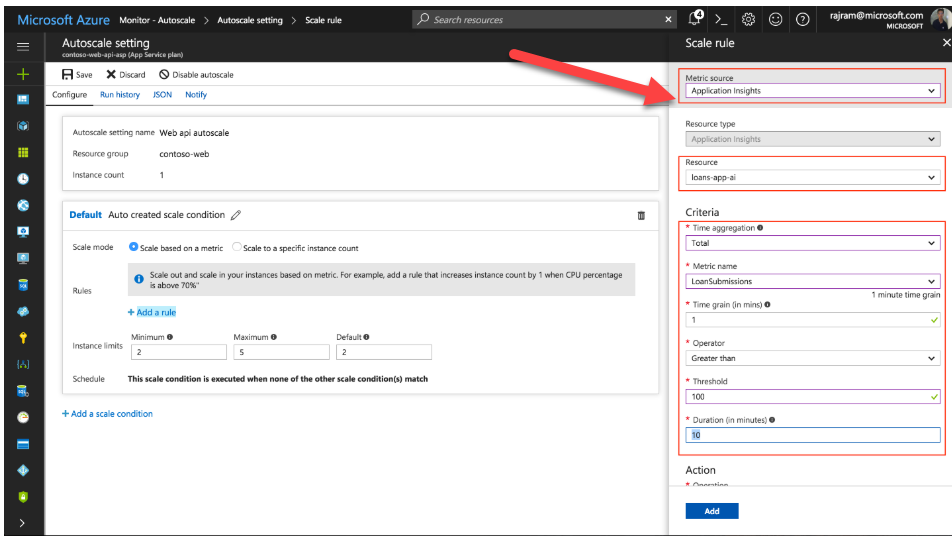

Since this is clearly mentioned in the Microsoft documentation, all other options are incorrect
For more information on autoscaling based on a custom metric, one can go to the below link
There is a plan to use Azure Cache for Redis to improve the performance of the “WhizlabsPolicyService” application. Which of the following would you store in Azure Cache for Redis?
- A. HttpContext.Items
- B. ViewState
- C. Session state
- D. TempData
Explanation:
Answer – C
You would ideally store the session state in Azure Cache for Redis. The Microsoft documentation mentions the following as one of the patterns or use cases for using Azure Cache for Redis

For more information on Azure Cache for Redis, one can go to the below link
You are developing an application that has a web and database tier. You have to store the database password as a secret in the Azure Key vault service.
You have to use Azure CLI commands to create the key vault and also create a secret in the key vault.
Which of the following command would you use to create the key vault?
- A. az create
- B. az keyvault create
- C. az secret create
- D. az keyvault secret set
Explanation:
Answer – B
To create the key vault, you have to use the az keyvault create command.
This is also given in the Microsoft documentation.
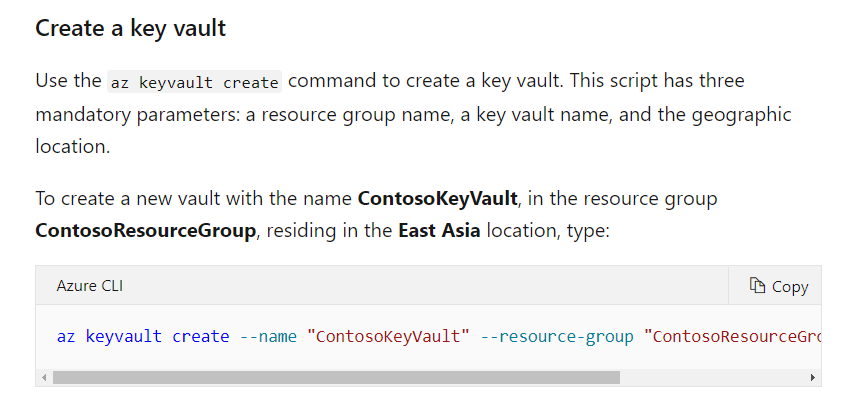
Since this is clearly given in the Microsoft documentation, all other options are incorrect
For more information on creating the key vault, please refer to the below link
You are developing an application that has a web and database tier. You have to store the database password as a secret in the Azure Key vault service.
You have to use Azure CLI commands to create the key vault and also create a secret in the key vault.
Which of the following command would you use to create the secret in the key vault?
- A. az create
- B. az keyvault create
- C. az secret create
- D. az keyvault secret set
Explanation:
Answer – D
To create the secret in the key vault, you have to use the az keyvault secret set command.
This is also given in the Microsoft documentation.

Since this is clearly given in the Microsoft documentation, all other options are incorrect
For more information on creating the key vault, please refer to the below link
A company is implementing an order processing system. The orders are going to be published to an Azure Service Bus topic. The properties of the messages that would be sent are as follows
|
Property |
Description |
|
Location |
The region of the shipment |
|
CorrelationId |
Used as the priority value for the order |
|
Quantity |
User defined property that defines the order quantity |
|
Audited |
User defined property that defines the order date |
The following subscriptions will be created. The requirement for each subscription is also given
|
Subscription |
Description |
|
LaterOrders |
This subscription will be used in the future and should not accept any orders at the moment |
|
HighPriorityOrders |
Here all the high priority orders should be sent |
|
GlobalOrders |
Here the order where the region is not USA should be sent |
|
HighOrders |
Orders where the quantity is greater than 1000 should be sent |
|
AllOrders |
For auditing purposes, all orders should be sent here |
You need to implement the right filters for each of the subscriptions given above.
Which of the following would you implement for the Subscription – HighPriorityOrders?
- A. SqlFilter
- B. CorrelationFilter
- C. TrueFilter
- D. No Filter
- E. FalseFilter
Explanation:
Answer – B
Since the priority is based on the CorrelationId , it is better to use the CorrelationFilter. The Microsoft documentation mentions the following with regards to the filter

Since this is the ideal filter to use, all other options are invalid
For more information on topic filters, one can go to the below link
A company is implementing an order processing system. The orders are going to be published to an Azure Service Bus topic. The properties of the messages that would be sent are as follows
|
Property |
Description |
|
Location |
The region of the shipment |
|
CorrelationId |
Used as the priority value for the order |
|
Quantity |
User defined property that defines the order quantity |
|
Audited |
User defined property that defines the order date |
The following subscriptions will be created. The requirement for each subscription is also given
|
Subscription |
Description |
|
LaterOrders |
This subscription will be used in the future and should not accept any orders at the moment |
|
HighPriorityOrders |
Here all the high priority orders should be sent |
|
GlobalOrders |
Here the order where the region is not USA should be sent |
|
HighOrders |
Orders where the quantity is greater than 1000 should be sent |
|
AllOrders |
For auditing purposes, all orders should be sent here |
You need to implement the right filters for each of the subscriptions given above.
Which of the following would you implement for the Subscription – GlobalOrders?
- A. SqlFilter
- B. CorrelationFilter
- C. TrueFilter
- D. No Filter
- E. FalseFilter
Explanation:
Answer – A
Here you can place a Sqlfilter based on the region. The Microsoft documentation mentions the following with regards to the filter

Since this is the ideal filter to use, all other options are invalid
For more information on topic filters, one can go to the below link
A company is implementing an order processing system. The orders are going to be published to an Azure Service Bus topic. The properties of the messages that would be sent are as follows
|
Property |
Description |
|
Location |
The region of the shipment |
|
CorrelationId |
Used as the priority value for the order |
|
Quantity |
User defined property that defines the order quantity |
|
Audited |
User defined property that defines the order date |
The following subscriptions will be created. The requirement for each subscription is also given
|
Property |
Description |
|
LaterOrders |
This subscription will be used in the future and should not accept any orders at the moment |
|
HighPriorityOrders |
Here all the high priority orders should be sent |
|
GlobalOrders |
Here the order where the region is not USA should be sent |
|
HighOrders |
Orders where the quantity is greater than 1000 should be sent |
|
AllOrders |
For auditing purposes, all orders should be sent here |
You need to implement the right filters for each of the subscriptions given above.
Which of the following would you implement for the Subscription – HighOrders?
- A. SqlFilter
- B. CorrelationFilter
- C. TrueFilter
- D. No Filter
- E. FalseFilter
Explanation:
Answer – A
Here you can place a Sqlfilter based on the quantity. The Microsoft documentation mentions the following with regards to the filter

Since this is the ideal filter to use, all other options are invalid
For more information on topic filters, one can go to the below link
A company is implementing an order processing system. The orders are going to be published to an Azure Service Bus topic. The properties of the messages that would be sent are as follows
|
Property |
Description |
|
Location |
The region of the shipment |
|
CorrelationId |
Used as the priority value for the order |
|
Quantity |
User defined property that defines the order quantity |
|
Audited |
User defined property that defines the order date |
The following subscriptions will be created. The requirement for each subscription is also given
|
Property |
Description |
|
LaterOrders |
This subscription will be used in the future and should not accept any orders at the moment |
|
HighPriorityOrders |
Here all the high priority orders should be sent |
|
GlobalOrders |
Here the order where the region is not USA should be sent |
|
HighOrders |
Orders where the quantity is greater than 1000 should be sent |
|
AllOrders |
For auditing purposes, all orders should be sent here |
You need to implement the right filters for each of the subscriptions given above.
Which of the following would you implement for the Subscription – AllOrders?
- A. SqlFilter
- B. CorrelationFilter
- C. TrueFilter
- D. FalseFilter
Explanation:
Answer – C
As per MS doc.
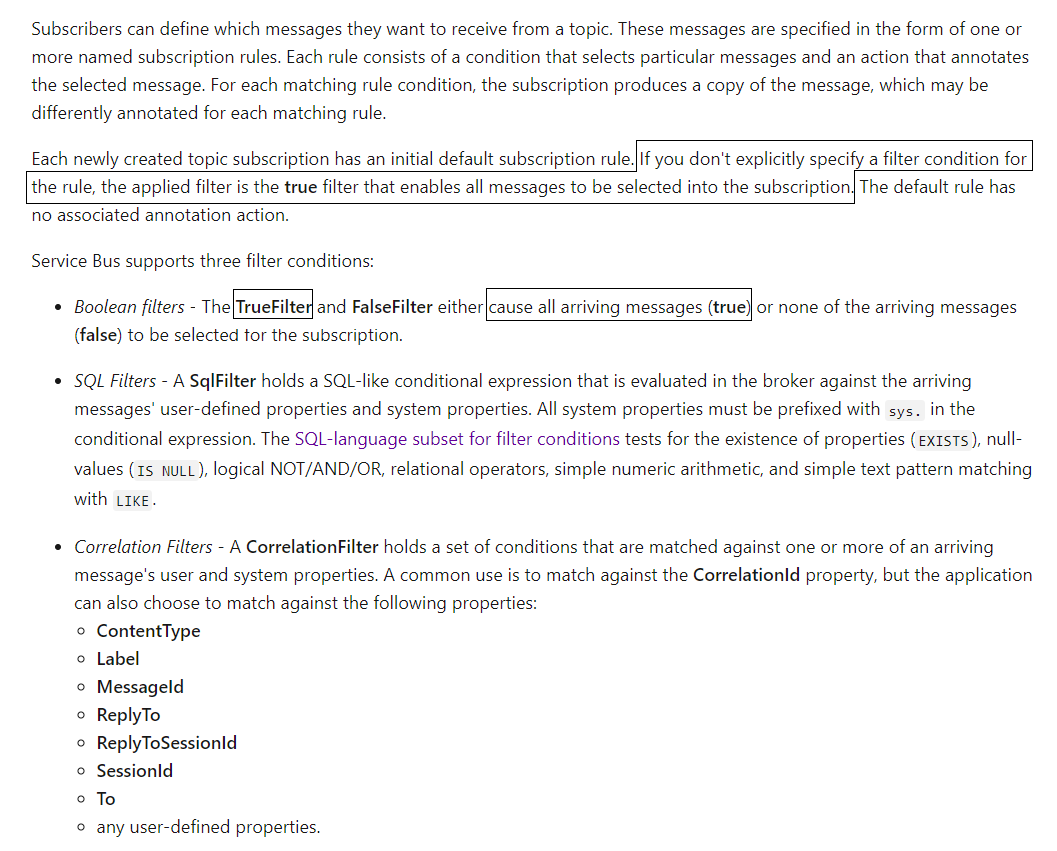 .
.
For more information on topic filters, one can go to the below link
Your company has an ASP.Net Core web application. This web application runs on Docker. The application is mapped to a domain named www.whizlabs.com.
The application needs to be hosted in Azure using Azure Web App service and the docker image for the web application. You also have to map a custom domain to the Azure Web app service. The following variables are in place
|
Variable name |
Description |
|
WhizlabsAppName |
Name of the application |
|
Location |
Location of the resource |
|
dockerHubContainerPath |
Location of the docker image |
You have to issue the required CLI commands for the provisioning process.
Which of the following would you issue to create the App Service plan?
- A. az appservice plan create --name whizlabsplan --resource-group whizlabs-rg
- B. az appservice plan create --name whizlabsplan --resource-group whizlabs-rg --location $location --is-linux --sku S1
- C. az appservice plan set --name whizlabsplan --resource-group whizlabs-rg --location $location --is-linux --sku S1
- D. az appservice plan docker create --name whizlabsplan --resource-group whizlabs-rg --location $location --is-linux --sku S1
Explanation:
Answer – B
An example of this is given in the Microsoft documentation
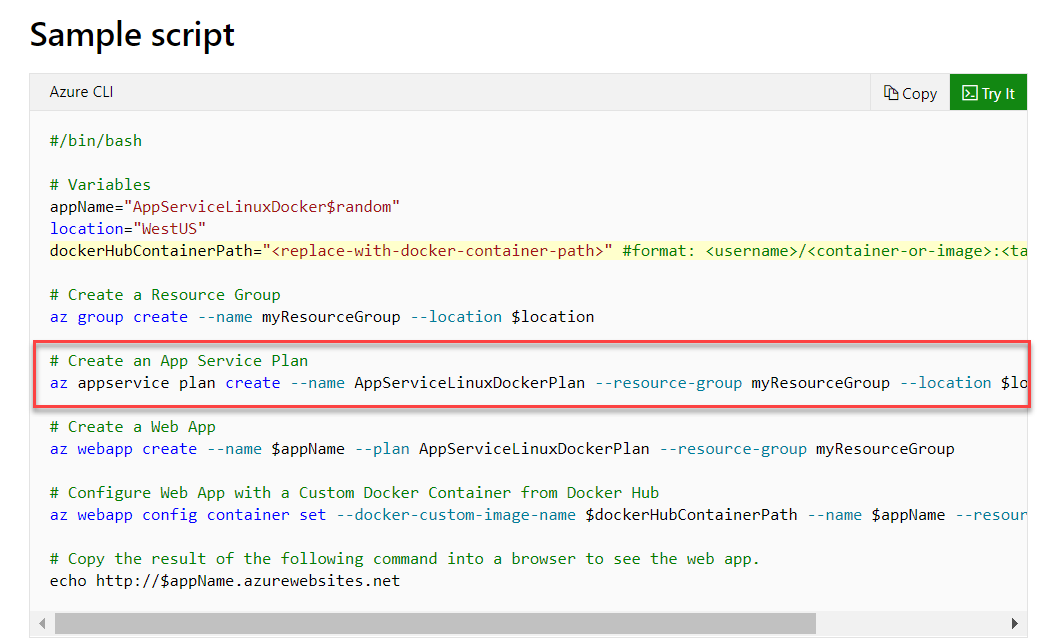
Since this is clearly given in the documentation, all other options are incorrect
For more information on create a linux docker web app, one can go to the below link
Your company has an ASP.Net Core web application. This web application runs on Docker. The application is mapped to a domain named www.whizlabs.com.
The application needs to be hosted in Azure using Azure Web App service and the docker image for the web application. You also have to map a custom domain to the Azure Web app service. The following variables are in place
|
Variable name |
Description |
|
appName |
Name of the application |
|
Location |
Location of the resource |
|
dockerHubContainerPath |
Location of the docker image |
Which of the following would you issue to create the Web App?
- A. az webapp create --name $appName --plan whizlabsplan --resource-group whizlabs-rg
- B. az webapp set--name $appName --plan whizlabsplan --resource-group whizlabs-rg
- C. az docker create --name $appName --plan whizlabsplan --resource-group whizlabs-rg
- D. az docker image create --name $appName --plan whizlabsplan --resource-group whizlabs-rg
Explanation:
Answer - A
An example of this is given in the Microsoft documentation
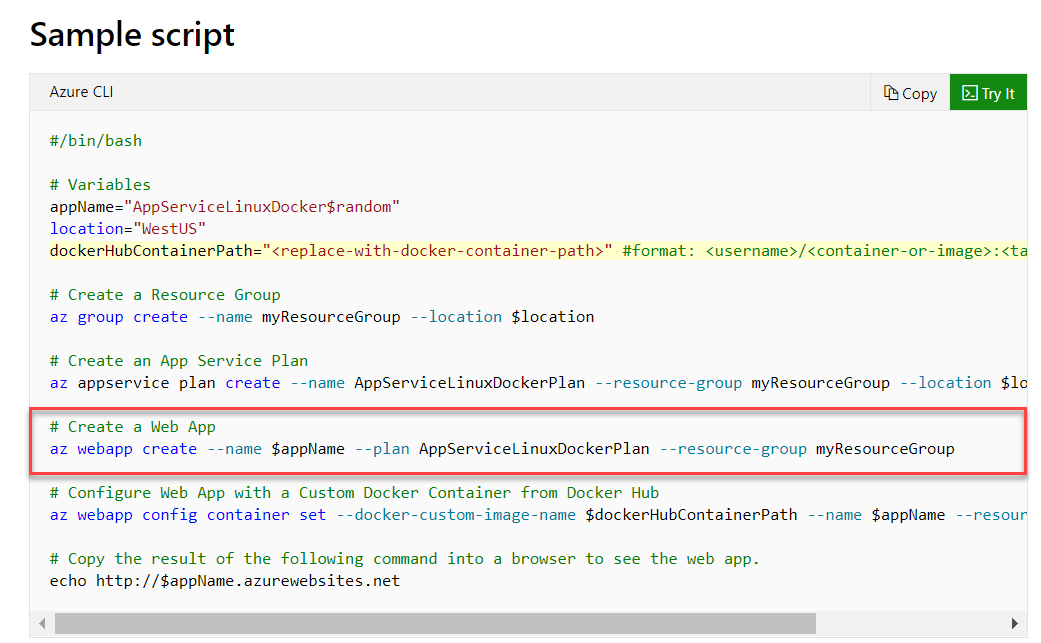
Since this is clearly given in the documentation, all other options are incorrect
For more information on creating a Linux docker web app, one can go to the below link
Your company has an ASP.Net Core web application. This web application runs on Docker. The application is mapped to a domain named www.whizlabs.com.
The application needs to be hosted in Azure using Azure Web App service and the docker image for the web application. You also have to map a custom domain to the Azure Web app service. The following variables are in place
|
Variable name |
Description |
|
WhizlabsAppName |
Name of the application |
|
Location |
Location of the resource |
|
dockerHubContainerPath |
Location of the docker image |
Which of the following would you issue to configure the Web App?
- A. az webapp config container set --docker-custom-image-name $dockerHubContainerPath --name $appName --resource-group whizlabs-rg
- B. az docker config container set --docker-custom-image-name $dockerHubContainerPath --name $appName --resource-group whizlabs-rg
- C. az kubernetes config container set --docker-custom-image-name $dockerHubContainerPath --name $appName --resource-group whizlabs-rg
- D. az kubectl config container set --docker-custom-image-name $dockerHubContainerPath --name $appName --resource-group whizlabs-rg
Explanation:
Answer - A
An example of this is given in the Microsoft documentation
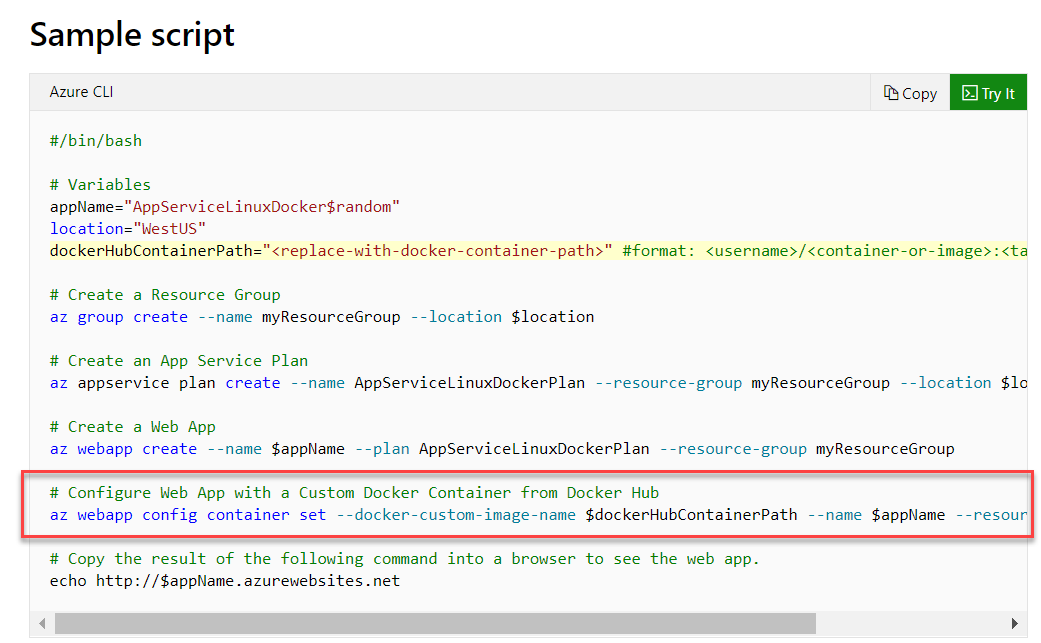
Since this is clearly given in the documentation, all other options are incorrect
For more information on create a linux docker web app, one can go to the below link
A company is developing a shopping application for Windows devices. A notification needs to be sent on a user’s device whenever a new product is entered into the application. You have to implement push notifications.
You have to complete the missing parts in the partial code segment given below
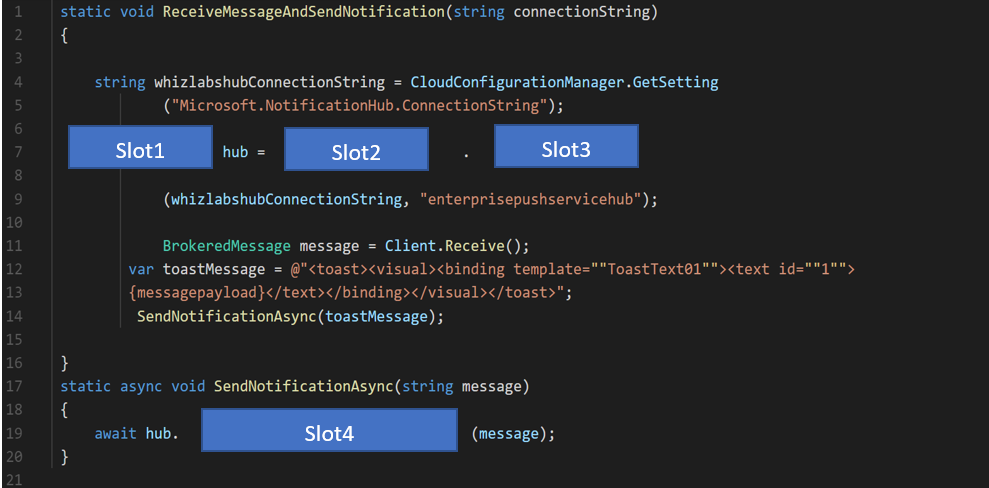
Which of the following would go into Slot1?
- A. NotificationHubClient
- B. NotificationHubClientSettings
- C. NotificationHubJob
- D. NotificationDetails
Explanation:
Answer – A
Please find the snippet of the code

An example of this is given in the Microsoft documentation
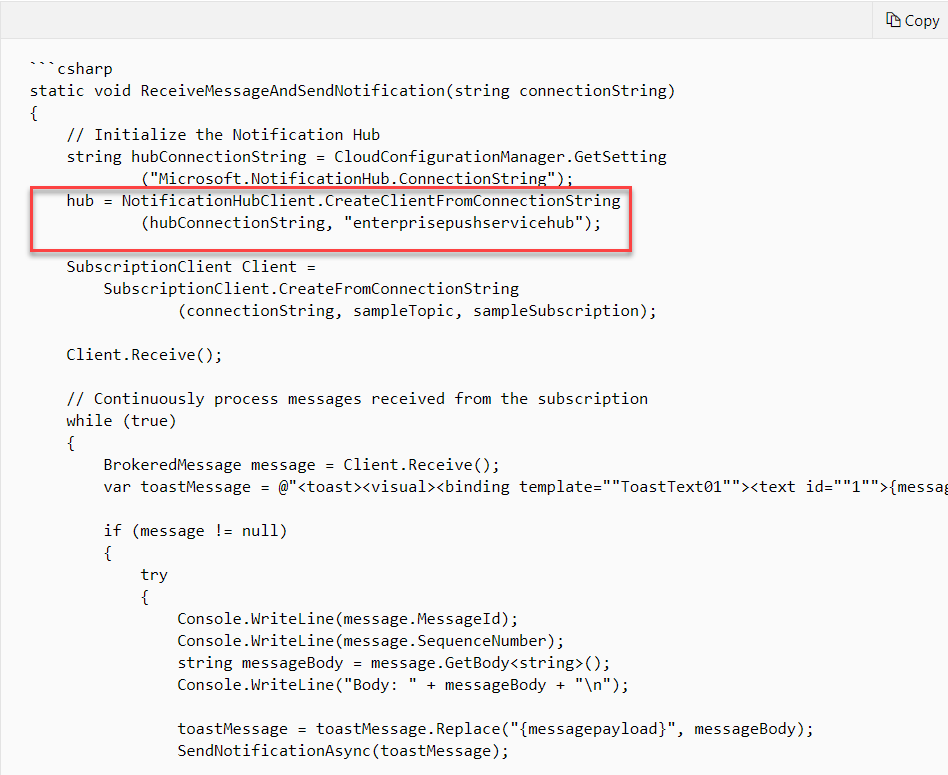
Since this is clearly given in the documentation, all other options are incorrect
For more information on enterprise push notification architecture, one can go to the below link
A company is developing a shopping application for Windows devices. A notification needs to be sent on a user’s device whenever a new product is entered into the application. You have to implement push notifications.
You have to complete the missing parts in the partial code segment given below
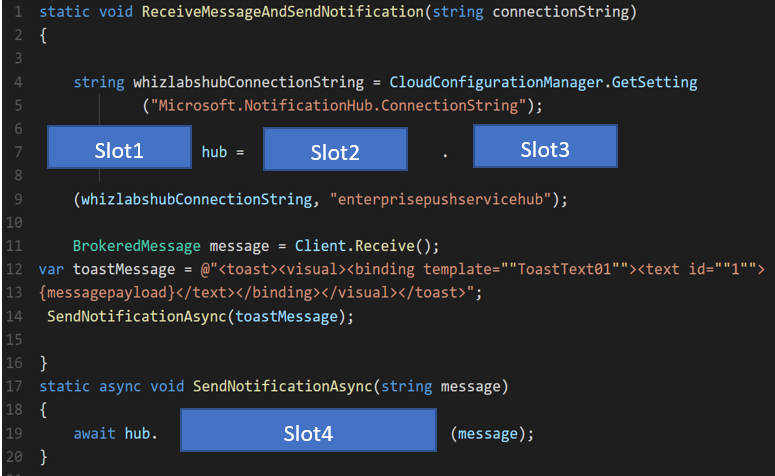
Which of the following would go into Slot2?
- A. NotificationHubClient
- B. NotificationHubClientSettings
- C. NotificationHubJob
- D. NotificationDetails
Explanation:
Answer - A
The full snippet of the code is

An example of this is given in the Microsoft documentation
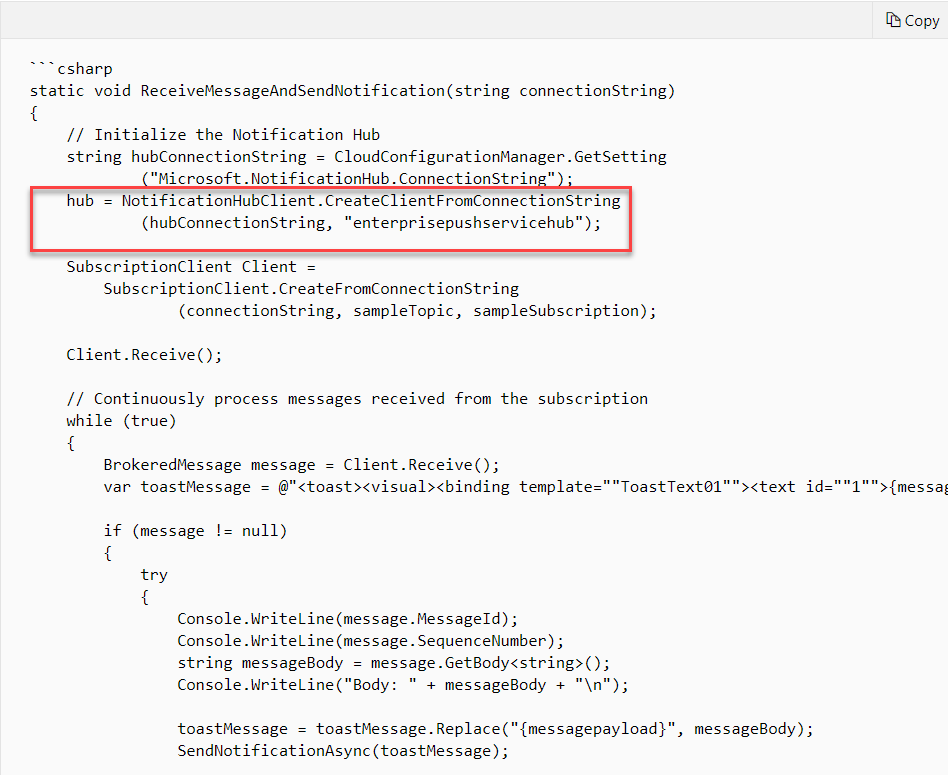
Since this is clearly given in the documentation, all other options are incorrect
For more information on enterprise push notification architecture, one can go to the below link
A company is developing a shopping application for Windows devices. A notification needs to be sent on a user’s device whenever a new product is entered into the application. You have to implement push notifications.
You have to complete the missing parts in the partial code segment given below

Which of the following would go into Slot3?
- A. GetInstallation
- B. CreateClientFromConnectionString
- C. CreateInstallation
- D. PatchInstallation
Explanation:
Answer - B
the full code is as follows
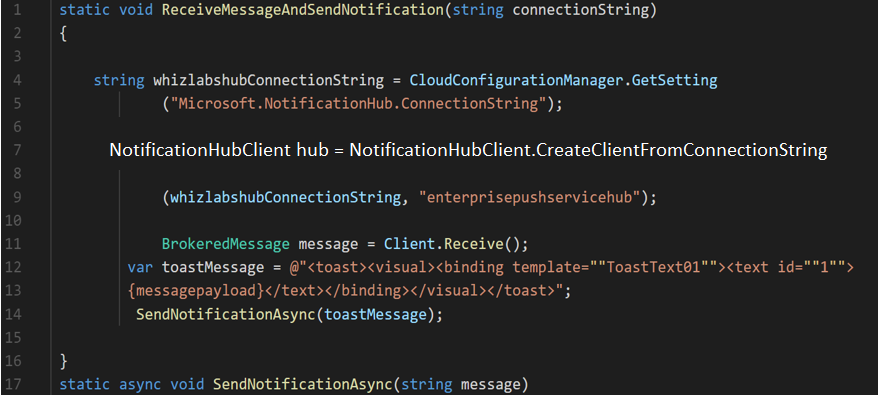
An example of this is given in the Microsoft documentation
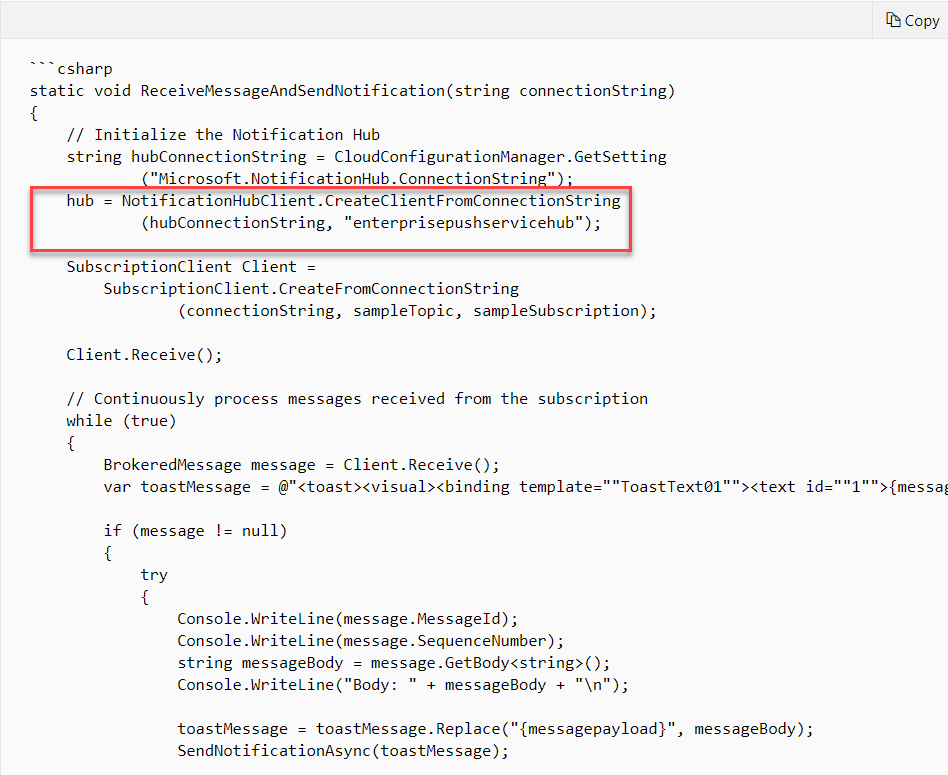
Since this is clearly given in the documentation, all other options are incorrect
For more information on enterprise push notification architecture, one can go to the below link
A company is developing a shopping application for Windows devices. A notification needs to be sent on a user’s device whenever a new product is entered into the application. You have to implement push notifications.
You have to complete the missing parts in the partial code segment given below

Which of the following would go into Slot4?
- A. SendWindowsNativeAsync
- B. SendWindowsNativeNotificationAsync
- C. ScheduleNotification
- D. ScheduleNotificationAsync
Explanation:
Answer - B
An example of this is given in the Microsoft documentation
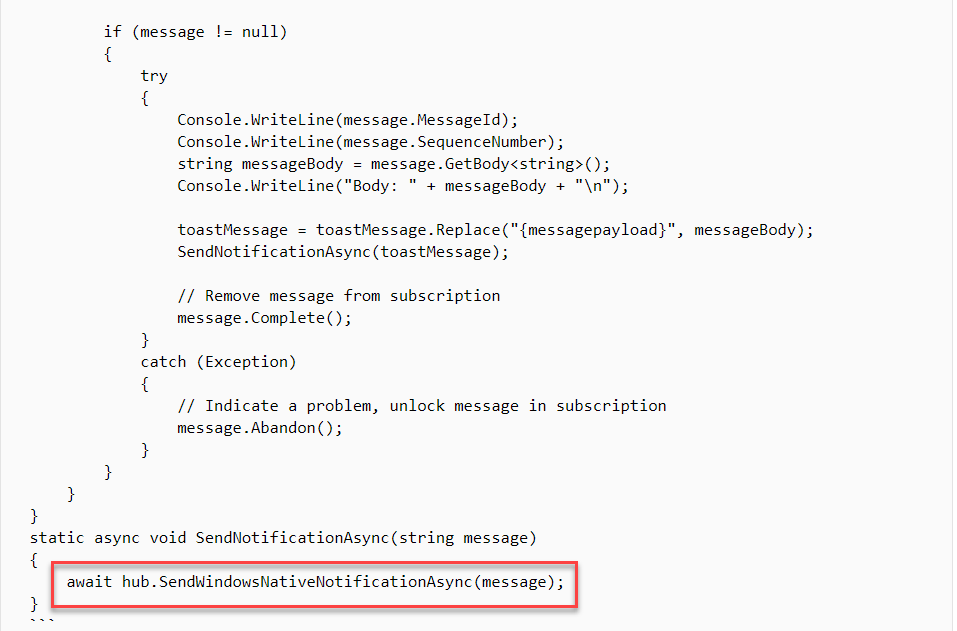
Since this is clearly given in the documentation, all other options are incorrect
For more information on enterprise push notification architecture, one can go to the below link
A company is developing an API system that will be hosted behind an Azure API Management service. You have to implement response caching. Here the user ID of the client must be detected and then the response must be cached for the given user ID.
You need to add the following policies to the policies file:
- A set-variable policy to store the detected user identity
- A cache-lookup-value policy
- A cache-store-value policy
- A find-and-replace policy to update the response body with the user profile information
To which policy section would you implement the policy for
“A set-variable policy to store the detected user identity”
- A. Inbound
- B. Outbound
- C. Error
- D. Parameters
Explanation:
Answer – A
Here since you need to detect the User ID from the request, you need to set the variable in the Input section. An example of this is given in the Microsoft documentation

Since this is clearly mentioned, all other options are incorrect
For more information on an example of managing requests with API management, one can go to the below link
A company is developing an API system that will be hosted behind an Azure API Management service. You have to implement response caching. Here the user ID of the client must be detected and then the response must be cached for the given user ID.
You need to add the following policies to the policies file:
- A set-variable policy to store the detected user identity
- A cache-lookup-value policy
- A cache-store-value policy
- A find-and-replace policy to update the response body with the user profile information
To which policy section would you implement the policy for
“A cache-lookup-value policy”
- A. Inbound
- B. Outbound
- C. Error
- D. Parameters
Explanation:
Answer – A
An example of this is given in the Microsoft documentation as shown below
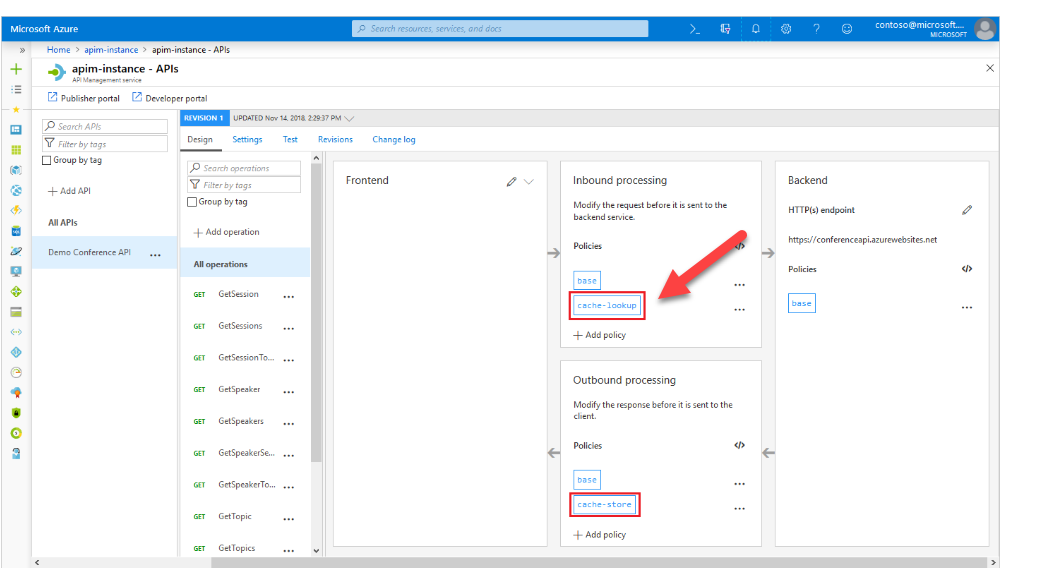
Inbound processing: Modify the request before it is sent to the backend service
cache-lookup policy
Outbound processing: Modify the response before it is sent to the client
cache-store policy
Since this is clearly mentioned, all other options are incorrect
For more information on how to work with the cache in API management, one can go to the below link
A company is developing an API system that will be hosted behind an Azure API Management service. You have to implement response caching. Here the user ID of the client must be detected and then the response must be cached for the given user ID.
You need to add the following policies to the policies file:
- A set-variable policy to store the detected user identity
- A cache-lookup-value policy
- A cache-store policy
- A find-and-replace policy to update the response body with the user profile information
To which policy section would you implement the policy for
“A cache-store policy”
- A. Inbound
- B. Outbound
- C. Error
- D. Parameters
Explanation:
Answer - B
An example of this is given in the Microsoft documentation as shown below
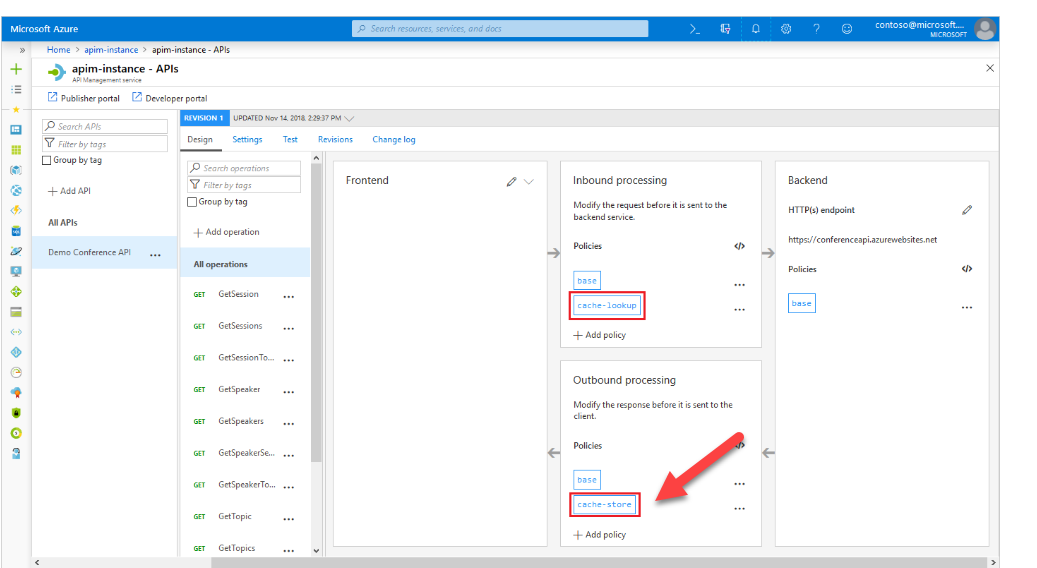
Since this is clearly mentioned, all other options are incorrect
For more information on how to work with the cache in API management, one can go to the below link
A company is developing an API system that will be hosted behind an Azure API Management service. You have to implement response caching. Here the user ID of the client must be detected and then the response must be cached for the given user ID.
You need to add the following policies to the policies file:
- A set-variable policy to store the detected user identity
- A cache-lookup-value policy
- A cache-store-value policy
- A find-and-replace policy to update the response body with the user profile information
To which policy section would you implement the policy for
“A find-and-replace policy to update the response body with the user profile information”
- A. Inbound
- B. Outbound
- C. Error
- D. Parameters
Explanation:
Answer – B
Here developer team need to
1. implement response caching.
2. user ID of the client must be detected
3. the response must be cached for the given user ID
Means policy need inbound and outbound configuration
To implement following
- A set-variable policy to store the detected user identity
- Need to place in inbound
- A cache-lookup-value policy
-
- Need to place in inbound
- A cache-store-value policy
-
- Need to place in outbound
- A find-and-replace policy to update the response body with the user profile information
-
- Need to place in outbound

Hence we have recommended Option B is correct answer
For more information on an example of managing requests with API management, one can go to the below link
A company has developed an application and deployed it to the Azure App Service. They have defined a scale-out condition that will scale the App if the average number of Active messages in a service bus queue is greater than 1000.
You need to ensure that the App service continually scales down with a scale down rule.
The scale rule is given below. You have to choose the right options for the scale rule to ensure the scaling down process occurs.
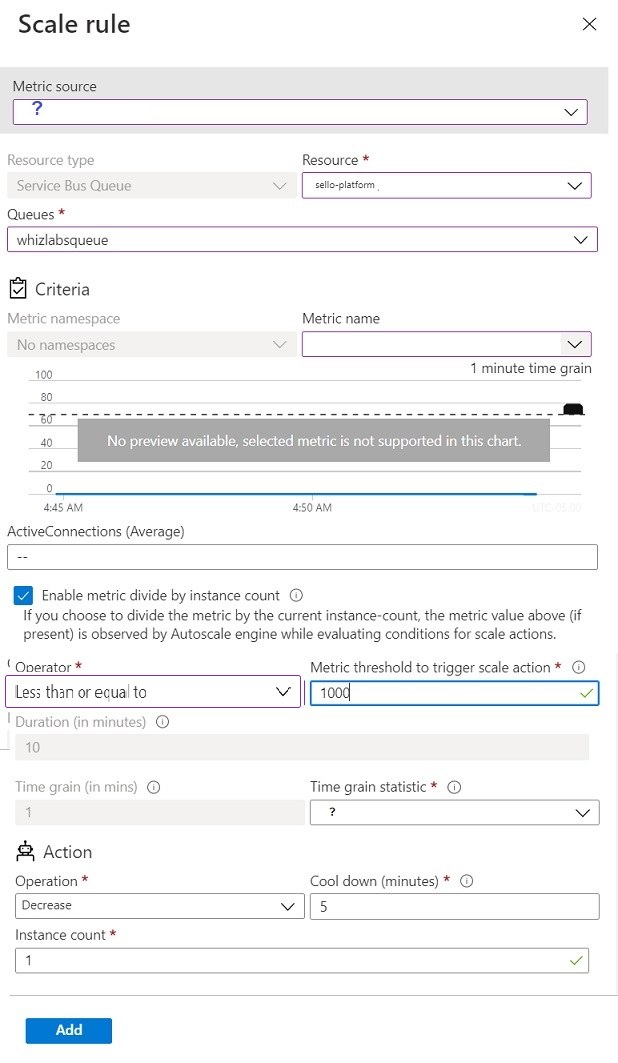
Which of the following would you choose as the metric source?
- A. Current resource(demoplan)
- B. Storage queue
- C. Service Bus queue
- D. Application Insights
Explanation:
Answer – C
Since there is already a scale-out condition based on the service bus queue, hence we need to ensure that we create a rule for the scale down again based on the service bus queue.
Because of this reasoning, all other options are incorrect
For more information on the scaling process in Azure Web Apps, one can go to the below link
Whizlabs has an On-Premises Active Directory Forest and an Azure Active Directory tenant. All Azure Active Directory users are assigned an Azure AD Premium P1 license.
You as an Azure Developer deployed Azure Active Directory Connect to sync with On-Premises Azure Active Directory Forest.
Which features are available to help the Help Desk of Whizlabs?
- A. Access Reviews
- B. Self-Service Password Change for cloud users
- C. Azure Active Directory Privileged Identity Management policies
- D. Vulnerabilities and risky accounts detection
Explanation:
Correct Answer – B
Self-Service Password Change for cloud users
To resolve this question 2 factors are important:
1. Feature available in Azure Active Directory license
2. Feature needs to help Help Desk professionals
Now look into the options:
A. Access Reviews
Available in P2
B. Self-Service Password Change for cloud users
Available in All licenses and also useful for Help Desk professionals
C. Azure Active Directory Privileged Identity Management policies
Available in P2
D. Vulnerabilities and risky accounts detection
Available in P2
For more information, please refer to the below link
A company has developed an application and deployed it to the Azure App Service. They have defined a scale-out condition that will scale the App if the average number of Active messages in a service bus queue is greater than 1000.
You need to ensure that the App service continually scales down with a scale down rule.
The scale rule is given below. You have to choose the right options for the scale rule to ensure the scaling down process occurs.

Which of the following would you choose for the "Metric Name"?
- A. Successful requests
- B. Incoming requests
- C. Active Messages Count
- D. Size
Explanation:
Answer - C
Since the metric for the scale out condition is based on the active message count, we need to also ensure that we choose the same metric for the scale down rule. The metric that can be chosen is shown below
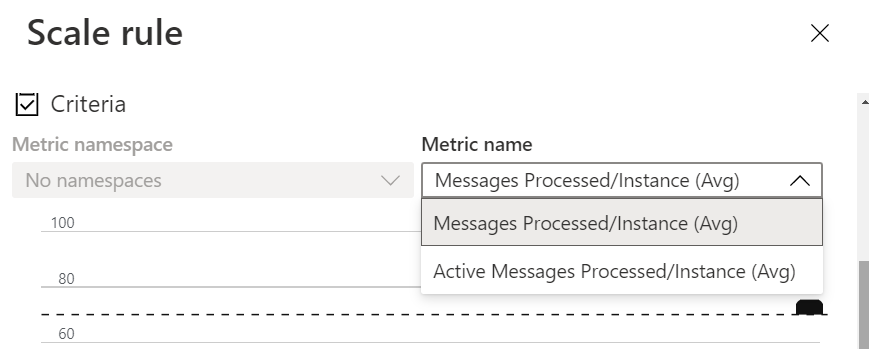
Because of this reasoning, all other options are incorrect
For more information on the scaling process in Azure Web Apps, one can go to the below link
A company has developed an application and deployed it to the Azure App Service. They have defined a scale-out condition that will scale the App if the average number of Active messages in a service bus queue is greater than 1000.
You need to ensure that the App service continually scales down with a scale down rule.
The scale rule is given below.
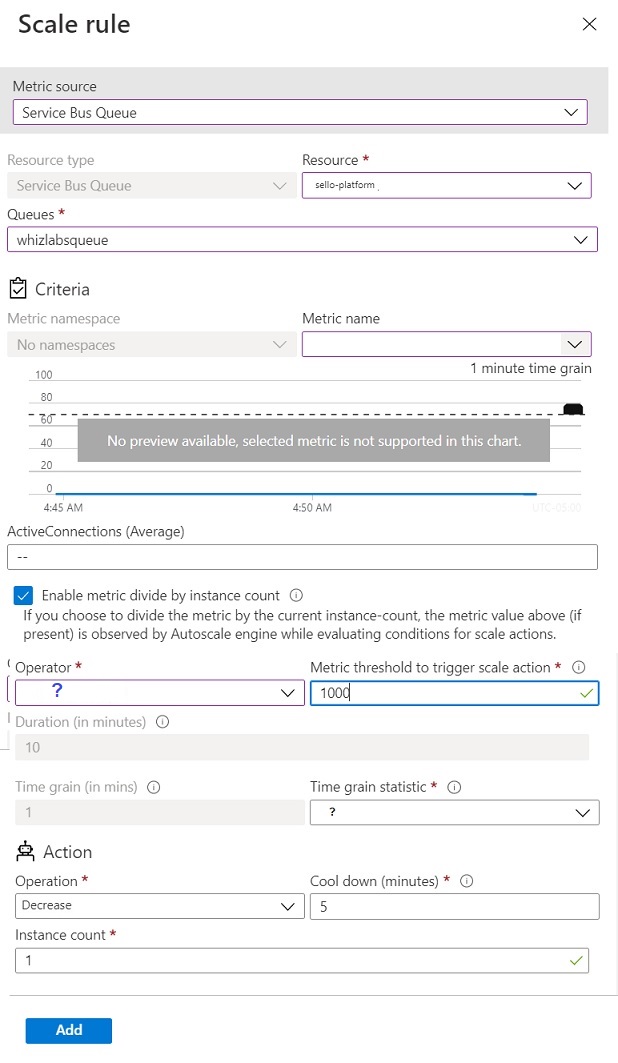
What should be filled in as the value for the "Operator"?
- A. Less than or equal to
- B. Greater than
- C. Not equal to
- D. Greater than or equal to
Explanation:
Answer - A
Since the metric for the scale-out condition is based on the “Less than or equal to” active message count, we need to also ensure that we choose the same metric for the scale down rule. The metric that can be chosen is shown below
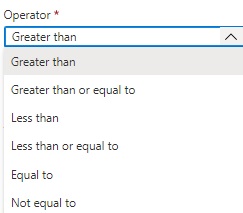
Because of this reasoning, all other options are incorrect
For more information on the scaling process in Azure Web Apps, one can go to the below link
A company has developed an application and deployed it to the Azure App Service and has created a Queue in Azure Service Bus having Premium pricing tier. They have defined a scale-out a condition that will scale the App if the average number of Active messages in a service bus queue is greater than 1000.
Now they need to ensure that the App service continually scales down with a scale in the rule.
Details of the scale in the rule are given below.
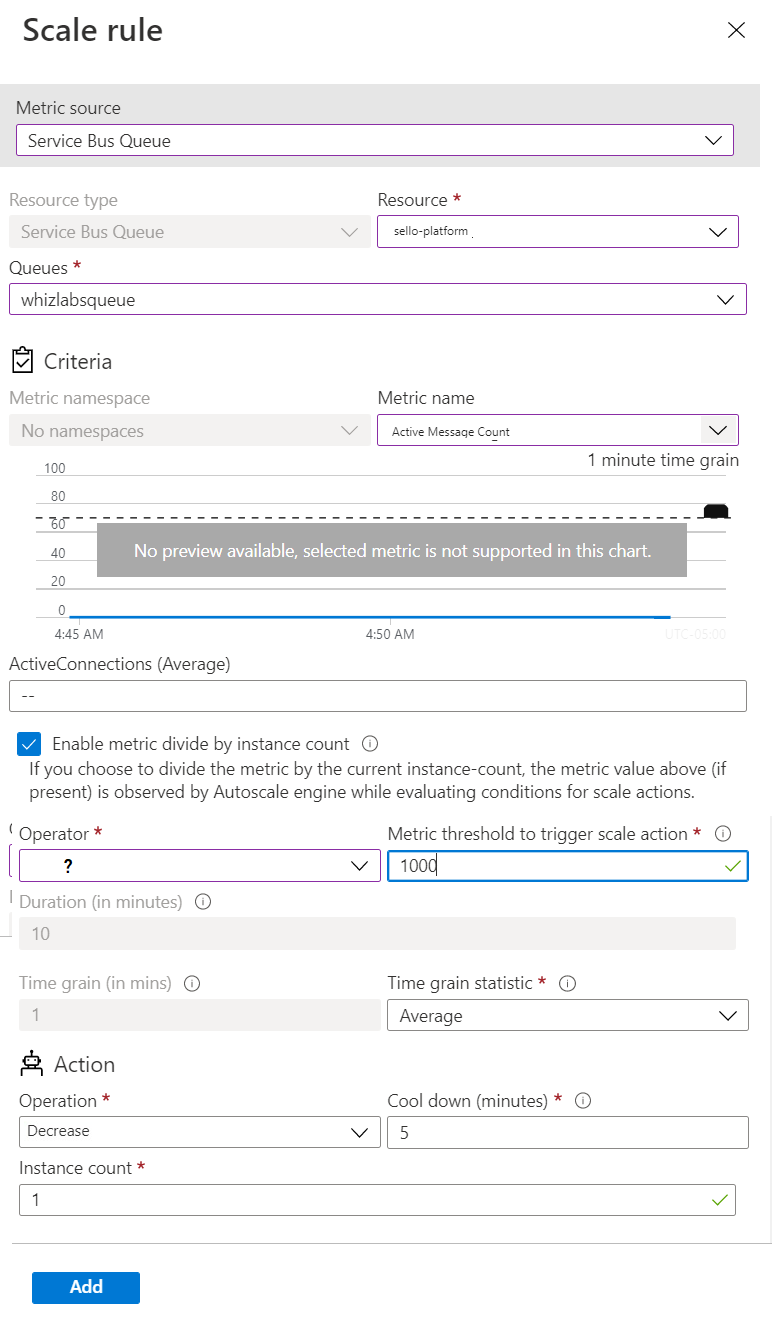
You have to choose the right Operator from drop-down options for the scale in rule to ensure the scaling down process occurs.
- A. Greater than
- B. Less than
- C. Less than or equal to
- D. Equal to
Explanation:
Answer - C
In the question
Scale Out rule : has already been created for average number of Active messages in a service bus queue is greater than 1000
hence we need to select "Less than or equal to 1000"
An example of this is shown below
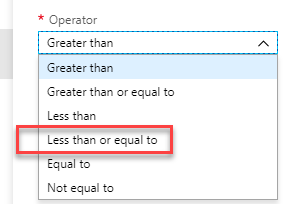
Because of this reasoning, all other options are incorrect
For more information on the scaling process in Azure Web Apps, one can go to the below link
A company has developed an application and deployed it to the Azure App Service. They have defined a scale-out condition that will scale the App if the average number of Active messages in a service bus queue is greater than 1000.
You need to ensure that the App service continually scales down with a scale in the rule.
The scale rule is given below. You have to choose the right options for the scale rule to ensure the scaling down process occurs.

Which of the following would you choose as the operation for the rule?
- A. Increase count by
- B. Increase percent by
- C. Decrease count by
- D. Decrease percent by
Explanation:
Answer - C
The scale-down rule should be used to reduce the number of instances, so we can use the Decrease count by rule. Use the “decrease percent by” when you want to reduce it by a particular percentage.
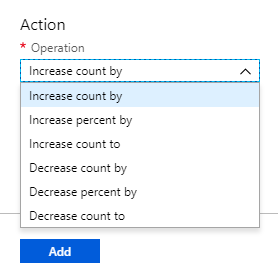
Because of this reasoning, all other options are incorrect
For more information on the scaling process in Azure Web Apps, one can go to the below link
A company is planning on developing a web app and deploying it to Azure. It will be based on .Net Core. They are also planning on using Application Insights to gain a deeper understanding on the usage of the Web application by users when it goes to production. They have the following requirements
- They need to know if most customers are progressing through the entire process in the application, or if they are ending the process at some point.
- Is page load time impacting how many people convert on my page
- Analyze how many users return to your app, and how often they perform particular tasks or achieve goals.
- Show how users navigate between the pages and features of your site
Which of the following Application Insight feature would they use for the requirement
“They need to know if most customers are progressing through the entire process in the application, or if they are ending the process at some point. “
- A. Funnel
- B. Impact
- C. Retention
- D. User Flows
Explanation:
Answer – A
This is clearly mentioned in the documentation

Since this is clearly mentioned in the documentation, all other options are incorrect
For more information on Application Insights – Funnels feature, one can go to the below link
A company is planning on developing a web app and deploying it to Azure. It will be based on .Net Core. They are also planning on using Application Insights on gaining a deeper understanding on the usage of the Web application by users when it goes to production. They have the following requirements
- They need to know if most customers are progressing through the entire process in the application, or if they are ending the process at some point.
- Is page load time impacting how many people convert on my page
- Analyze how many users return to your app, and how often they perform particular tasks or achieve goals.
Show how users navigate between the pages and features of your site
Which of the following Application Insight feature would they use for the requirement
“Is page load time impacting how many people convert on my page”
- A. Funnel
- B. Impact
- C. Retention
- D. User Flows
Explanation:
Answer – B
This is clearly mentioned in the documentation

Since this is clearly mentioned in the documentation, all other options are incorrect
For more information on Application Insights – Impact feature, one can go to the below link
A company is planning on developing a web app and deploying it to Azure. It will be based on .Net Core. They are also planning on using Application Insights on gaining a deeper understanding on the usage of the Web application by users when it goes to production. They have the following requirements
- They need to know if most customers are progressing through the entire process in the application, or if they are ending the process at some point.
- Is page load time impacting how many people convert on my page
- Analyze how many users return to your app, and how often they perform particular tasks or achieve goals.
Show how users navigate between the pages and features of your site
Which of the following Application Insight feature would they use for the requirement
“Analyze how many users return to your app, and how often they perform particular tasks or achieve goals”
- A. Funnel
- B. Impact
- C. Retention
- D. User Flows
Explanation:
Answer – C
This is clearly mentioned in the documentation

Since this is clearly mentioned in the documentation, all other options are incorrect
For more information on Application Insights – Retention feature, one can go to the below link
A company is planning on developing a web app and deploying it to Azure. It will be based on .Net Core. They are also planning on using Application Insights on gaining a deeper understanding on the usage of the Web application by users when it goes to production. They have the following requirements
- They need to know if most customers are progressing through the entire process in the application, or if they are ending the process at some point.
- Is page load time impacting how many people convert on my page
- Analyze how many users return to your app, and how often they perform particular tasks or achieve goals.
Show how users navigate between the pages and features of your site
Which of the following Application Insight feature would they use for the requirement
“Show how users navigate between the pages and features of your site”
- A. Funnel
- B. Impact
- C. Retention
- D. User Flows
Explanation:
Answer – D
This is clearly mentioned in the documentation

Since this is clearly mentioned in the documentation, all other options are incorrect
For more information on Application Insights –Usage Flows feature, one can go to the below link

